

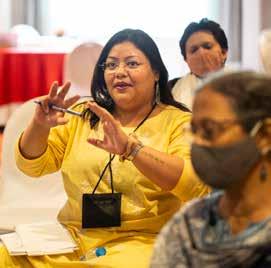
“If we have no peace, it is because we have forgotten that we belong to each other.”
- Mother Teresa




“If we have no peace, it is because we have forgotten that we belong to each other.”
- Mother Teresa
Tuesday, 6 August 2024
9:30 AM Registration
Inauguration of the Event- Welcome by Elizabeth Neuville
Introduction to the Course and Faculty
Tea/Coffee Break
PART 1 : The Wounding Life Experiences
Presentation: Social Devaluation through Negative Roles
1:30 PM Lunch
Plenary Session: The Wounding Life Experiences (cont’d)
Tea/Coffee Break
Plenary Session: The Wounding Life Experiences (cont’d)
Small Group Discussion: Devaluation and its Consequences
6:00 PM End of Course Day
7:30 PM - 10:00 PM Dinner
Wednesday, 7 August 2024
9:00 AM Two Group Reflections on Devaluation: “My Favorite Devalued People” and “The Universality of Oppression”
Start of the Day: Morning Reflection; Burning Issues
PART 2: Social Role Valorization
A “Bird’s Eye View” of SRV: E. Neuville
Tea/Coffee Break
Some Positive Examples: G. Mondol and E. Neuville
Introduction to the Themes of SRV: The Red Thread of the CVA
1:00 PM Lunch
Unconsciousness
Tea/Coffee Break
Unconsciousness Small Group Session Part 2
The Conservatism Corollary (presentation and discussion)
Program Close
7:30 PM - 10:00 PM Dinner
Evening Discussion (Optional)
“Film Screening- Valuing Lives: Wolf Wolfensberger and the Principle of Normalization”
Thursday, 8 August 2024
9:00 AM Program Start
Prevent, Reduce and Compensate small group work (All Faculty)
The Dynamics of Interpersonal Identification (Presentation and Discussion)
Tea/Coffee break
The Power of Mindsets
The Dynamics of Role Circularity (presentation and discussion)
1:00 PM Lunch
Symbolism and Imagery Use (presentation and discussion)
Tea/Coffee Break
Model Coherency (presentation and discussion)
Personal Competency Enhancement and The Developmental Model (Presentation and Video)
7:30 PM - 10:00 PM Dinner
Evening Discussion (Optional): SRV Implementation in the Indian Experience
Friday, 9 August 2024
9:00 AM
Program Start
The Power of Imitation (Presentation and Discussion)
Tea/Coffee Break
Personal Social Integration and Valued Social Integration (Presentation, discussion and video)
PART 3: Implementation of SRV
1:00 PM Lunch
Preparation for the Implementation of SRV: Small Group Session Evaluation
Tea/Coffee Break
Where do we go from here? India’s Inclusive Future, Presentation of Certificates, Vote of Thanks and Concluding Video
5:00 PM Program Close
Dear Course Participants,
On behalf of the Keystone Institute India, the All-India SRV Association and our sponsoring organizations and collaborating partners at The Rural India Supporting Trust, we extend a warm welcome to you. It is our hope and expectation that the next four days are ones full of deep reflection on your commitment, your direction, and your own work in assisting people with disabilities to take their full place in society. We are pleased to offer this workshop as a continued expression of our commitment in support of services which are truly responsive to the needs of the people who are served. It is our hope that you will join many others over the years for whom this event has been a pivotal one – one which shapes our understanding and demands that we commit to listening more carefully and learning more deeply.
We have a carefully-developed participant group formed from leaders across India, and it is our intention that this course will strengthen your foundation, build your strength, connect you with others, and fuel the movement across India towards a society where all people, including those with disabilities, belong and are truly valued. We are all on the leading edge of change in India, and we will strengthen each other’s work.
We are so fortunate to have skilled presenters and group leaders for this workshop. Our workshop faculty members are experienced in SRV theory and implementation and have made significant commitments to learning and growing in this area. We are grateful for their time and experience. They serve as resources and connections for you, so please do share information, talk with them, and connect.
We are glad that you put aside the time to invest in this demanding and rigorous learning event, and we hope that you will leave this course with a passion to learn more. There is a broad range of opportunities for people wishing to pursue development and implementation of Social Role Valorization. We are excited about working in partnership with you in your personal and professional development, as well as serving as a resource to you in making a difference in the lives of the people you support. This event promises to be a landmark of sorts in the work towards creating a society that works for everyone, and we are glad to be sharing this experience with you.
Elizabeth Neuville Executive Director Keystone Institute India
The materials in this manual, and those presented in the workshop, are offered with deep appreciation to the major developer, Dr. Wolf Wolfensberger, as well as those who have contributed to the teaching and development over the past decades. Please respect the work and do not copy or disseminate further. All materials are taught with permission from the developers.
This is an invitational residential course offered to selected applicants nominated by the collaborating partners and past program graduates. Collaborating partners are The Rural India Supporting Trust, and Keystone Institute India (KII)
Course Organizer: Keystone Institute India
Prashansa Pandey, Project Leader-Events and Workshops ppandey@khs.org +919779754828
This is a residential course, with participants arriving 5th evening. Because of the long hours and rigorous focus required, all invitees are requested to stay overnight at the hotel if possible. The course will conclude by close of day on 9th August. Participants will check out of the hotel that morning and should make arrangements to depart in the evening, after the close of the session, or as organized by the Course Organizer.
Participation in this course will be by invitation to apply only. Nominations selection was based on perceived leadership qualities, likelihood of influence in shaping policy and practice in disability services, and openness to change and critique of standard service models. Invitees include family members, professionals, and people with disability.
All nominees must have a firm and fluent ability to communicate in English. Translation into other languages unfortunately is not possible for this intensive course in this four-day timeframe, however, accommodations will be made by all in informal assistance with accent differences and understanding from our diverse national and international attendees and faculty.
The workshop will be limited to selected participants, with most coming from geographic areas outside Delhi. Travel costs are provided for those attending from outside of Delhi, and accommodation costs are included for all participants. A certificate will be given to all those who successfully complete the course. Implementation project support and leadership development (i.e., “train the trainer”) will be offered by KII as a follow-up to this workshop for selected participants. All successful participants will join the All -India SRV Leadership Network, with access to national SRV experts and practitioners across India.
The theory of Social Role Valorization (SRV) and its predecessor idea, the Principle of Normalization, was first developed in North America in the early 1970s by Dr. Wolf Wolfensberger. At the time, inhumane conditions prevailed in North American institutions, where many thousands of people with disabilities were segregated, congregated, abused and imprisoned. Normalization, and later Social Role Valorization, informed and impassioned a generation of architects of the community system as they envisioned a society in which people with disabilities could experience freedom, dignity and the opportunity to experience ”the good things in life.”
SRV is a social theory that examines and helps us understand the process of social devaluation – how do people come to be at the bottom of the social ladder, and what are the predictable “bad things” likely to come their way once they lose value within the society? These “bad things” have been descriptively called the “wounds” of social devaluation and are inflicted on devalued people relentlessly, systematically and often unconsciously. They include such experiences as being profoundly rejected, being thrust into negatives roles such as “eternal child” or “menace” or “object of pity,” being stigmatized by the attachment of devastating imagery, being distanced and segregated from society, and many other hurtful and damaging experiences. SRV states that the good things in life that we all strive to have, such as freely-given relationships, belonging, a good reputation, contribution and personal growth, tend to come to people who have many positively valued social roles, such as neighbor, student, citizen, family member, etc. If we can assist people to move into valued roles, we increase the likelihood that people will have access to these good things. Today, Social Role Valorization remains highly relevant and useful within all fields working to make things better for marginalized and oppressed people. Understanding the societal forces of devaluation and how to effectively work towards a full, rich meaningful life alongside affected people equips us to work for real change in the world.
The training is an intensive four-day theory workshop which presents the idea of assisting people with disabilities and other devalued conditions to have positive social roles as a productive and helpful response to those wounding life experiences. This foundational material is essential to those wishing to serve others in meaningful ways, and who are impassioned to make a difference in the lives of others.
The framework of Social Role Valorization is taught through the elaboration of ten themes:
! The Power of Unconsciousness
! Imagery
! Positive Compensation for Disadvantage
! Role Circularity
! The Developmental Model
! Service Model Coherency
! Social Integration
! Identification
! Imitation
! Mindsets
This course will include multi-media presentation, small and large group reflection and discussion, and resource materials. Participants should be prepared for significant segments of presentation as well
as group work. As well, participants are reminded that this is a serious-minded workshop for seriousminded people who are interested in real change. The format is rigorous, the expectations are high for full investment by all participants, and the opportunities for joining a community of committed change agents within India and around the world is high.
Although focused on theory, the structure of this introductory course allows for participants to discuss and challenge each other through multiple small group experiences lead by experienced group leaders interspersed throughout the four days.
The principles and ideas you will be learning about will be much more impactful when you can see how they have affected the life of a person you are connected to in your own life. Additionally, learning about Social Role Valorization is most enriching and meaningful when you come to the workshop prepared. This includes spending some time with a person who is vulnerable or devalued, perhaps a person you have met through your work who experiences a disability or impairment. In preparation for the Social Role Valorization workshop, please:
Familiarize yourself with the information pertaining to the life story of someone you know who lives with a devalued identity or condition. This will be your “focus person” for the material. The more fully you prepare this assignment, the more you will be able to personalize the material and draw guidance from it. Try to find out the following information about the person:
1. What relationships with family and friends does this person have, and what are the attributes of these relationships?
2. What type of residence does the person live in?
3. What type of day program, school, or work does the person have?
4. What is a typical day in the life of this person?
5. What does the person want in terms of their lifestyle and future?
6. What do others see in the future for this person?
7. What are the person’s strengths and gifts?
8. Are there other relevant details?
Please remember that all of this is confidential and for your learning only. It would be a good idea to ask the person you are writing about for their permission to use the information. Please invest time into preparing this information, as the more you invest in it, the richer your learning experience will be.
Thank you!
Elizabeth Neuville serves dual roles as Executive Director of the Keystone Institute, a US-based educational Institute, and Director of Keystone Institute India. She has nearly 40 years of experience within Keystone Human Services as a human service worker, administrator, agency director, evaluator, educator, and personal advocate, as well as extensive experience in designing and developing supports for very vulnerable people, meaningful quality measurements, and extraordinary employee development programs.
Betsy has worked extensively with the ideas of Normalization and Social Role Valorization, and provides training and consultation internationally, with extensive experience in Central and Eastern Europe, and, in recent years, India. She is fully accredited by the North American Social Role Valorization Council as a senior trainer of SRV, and co-founded the International SRV Association in 2015. She has led SRV and person directed practice initiatives in Canada, across the United States, India, Republic of Moldova and other countries across the World.
She studied under the mentorship of Dr. Wolf Wolfensberger, the developer and foremost proponent of SRV, and has, in turn, mentored and supported a generation of people committed to personal human service to others. Elizabeth is a founding member of the International SRV Association, and has written and presented extensively on the subject.
She began involvement with using the tools and techniques of PersonCentered Planning in 1992 as a means to move people towards better lives, and has extensively studied and used the work of Beth Mount in Personal Futures Planning and Jack Pearpoint in PATH and MAPS. She has taught person centered planning techniques across North America, India, Romania, the republic of Moldova, and Azerbaijan. She has developed techniques which merge the use of traditional PC planning with Social Role Valorization and Model Coherency, increasing the likelihood that such processes will involve identifying and meeting true needs, as well as incorporating the use of valued social roles.
Betsy divides her time equally between India and the US. She holds a Master of Science in Disability Advocacy and Leadership, and a Bachelor of Arts in Psychology and English from Bucknell University.


Ms. Geeta Mondol serves as Director of Community Programs, providing consultation and education in our many programs and events. Geeta has decades of experience in working with, and being with, people with disabilities, and is also a parent of two young men, one of whom experiences autism.
Geeta leads programmatic aspects of a pilot project which assists women with developmental disability who have been abandoned in institutions to reestablish themselves as valued and contributing members of their communities, as well as heads up a highly successful program to re-unify institutionalized people with disabilities with their families.
She has been involved in conducting training on inclusion and integration of people with disabilities with many organizations in various parts of the country and abroad. Her early years involved working in a mainstream school helping include those with disabilities in the mainstream classrooms. Currently, she works within KII to create exit paths from government institutions so that some of society’s most rejected people can experience genuine community life.
Geeta was a pioneer by completing the inaugural Social Role Valorization (SRV) 1.0 training course in 2016, and assists to implement SRV within organizations and in the life of her family. She has participated in pilot projects using person-centered planning, and served as a member of multiple planning circles, both in training simulations and in bona fide planning sessions. She attended PASSING SRV Service Assessment training in the United States in 2019.
Leela Raj is the Project Leader for multiple change initiatives within Keystone Institute India. Leela has a passion for education and change agentry, and is committed to collaborative work building capacity and awareness. She first connected with the ideas of Social Role Valorization during her Masters work in Rehabilitation Sciences at the University of Kentucky, and has been working closely with us since her return to her home city of Mumbai. Her portfolio at KII includes developing high quality curriculum for the development and formation of direct service workers as a developing role in India and leading the Supported Employment initiative in India.

Leela brings a great deal of experience and commitment with her, as a mentor, counselor, advocate, and activist working alongside young adults with developmental disability and their families.

Ranjana Chakraborty brings experience and deep commitment to her teaching and facilitation in Social Role Valorization and inclusive practice. A founding member of the All-India SRV Leadership Network, Ranjana joins the team of Associate Faculty for KII, working together across India for change. She is an experienced implementor of ideas related to SRV, and has particular expertise in evaluating service practices. Her role as a Board Member at Autism Society West Bengal, one of the leading organizations promoting the ideas of Social Role Valorization in India, as well as being a qualified special educator and family member of a person experiencing disability, bring both perspective and experience to bear as we move toward a different way to think about disability. From Kolkata, West Bengal, Ranjana’s background in microbiology brings diversity of thinking and rigor to her approach. As well, Ranjana’s advanced training in Social Role Valorization in US and India are supplemented by her passion for change.

Dr. Manisha Bhattacharya is a Clinical Psychologist from Kolkata, India, where she uses SRV-informed strategies to assist people with autism and their families to lead full, meaningful lives. A firm supporter of inclusive practices, she has completed advanced training in Social Role Valorization in India and in the United States, with experience in service evaluation. She teaches SRV in both English and Bengali, and has pioneered the advancement of SRV to Bengali and Bangla speakers in India and Bangladesh. Dr. Bhattacharya also has experience in person-centered planning facilitation, using methods which include Personal Futures Planning, PATH, and others.
Bringing over a decade of experience to the field, she provides early intervention support to young children, as well as counseling for teenagers and adults with an eye towards preserving their psychological and general wellbeing through achieving meaningful life experiences.
With specialized training in Social Role Valorization (SRV) and PASSING from Keystone Institute, USA, Dr. Bhattacharya embeds these ideas in her practice so that each individual with any disability can move toward a valued, fulfilling, and meaningful life, and has taken leadership within the All-India SRV Leadership Network, with a special focus on program evaluation.
Dr. Bhattacharya completed her Ph.D. in Psychology from the University of Calcutta. She is also a certified Narrative Practitioner, exploring alternative ways of seeing disability and searching for ways that people with disability themselves can name, define, and address difficulties they are facing. She has been integrally engaged with Keystone Institute India as a partner and colleague for well over five years.

Aparna Das is the Founder and Director of Arunima: A Project for People with Autism. A special educator with over three decades of experience, Aparna started her career at AADI (formerly called the Spastics Society of Northern India.) She then went on to work at Woodstock School, an international boarding school in Mussoorie, where she set up and headed the Learning Assistance Program for a number of years. While she was at Woodstock, Aparna reflected on the needs of her younger sibling, Arunima, who is on the Autism Spectrum, realizing that she too needed a life that was focused on her and a support community that would be there for her when Aparna was no longer around. Thus, Project Arunima, a program offering residential services and opportunities to build skills, was born in 2011. It is a one-of-a-kind program that aims at providing opportunities for a life of independence and dignity for people who are differently abled. What makes it one-of-a-kind? In a nutshell—the recognition that different is not less, but equal! Aparna is passionate about creating these opportunities for a good life to ensure that each person is a valued member of the community.
Sudha S. Nair is passionate about the work she does alongside people with disabilities She has been in the field of Special Education for the last 27 years, the last 17 years especially in Inclusive Education. She has had the responsibilities of setting up an Autism Unit in a Special Needs Centre as well as a Learning Support Unit in a Mainstream School during her employment in Dubai. As a self-employed professional in India, she has been actively involved in working side by side with parents as well as school educators and counselors to work for and champion her neurodiverse students. Her introduction and further exploration of the themes of SRV has added a valuable dimension to her commitment and thinking, especially while designing programmes for her students.

She has recently founded the SuDhi Learning Centre which aims to be a training hub as well as to co-create shared spaces for belonging and interpersonal identification in the community. She attended Social Role Valorization 3.0 in 2019, and has been an active member of the All -India SRV Association since its inception. She has had a great deal of experience incorporating SRV thinking into her work, and has introduced many others to the ideas.
She loves reading (or should we say, collecting books!), pottering around her little garden, playing with her two adorable pets, dabbles in sketching, when she isn’t working or being brought up by the two young ladies, she gave birth to.

Grace Daniel joined Keystone Institute India as the program lead for inclusion and communication.
Professionally Grace is a Special Educator with over two decades of experience. She is passionate about inclusive schooling. She serves as the Founding Director of I Care Rehabilitation Center, an inclusive NGO that works with children and adults with disabilities and provides educational opportunities for underprivileged girls and people who did not complete school or college.
Grace is a creative and artistic person who serves as graphic facilitator with Keystone Institute India. She has an excellent ability to take words and thoughts and organize them to create a beautiful visual expression of the process of discussion, a visual treasure.
After completing the comprehensive Social Role Valorization (SRV) course in 2017, Grace has been actively involved in implementing the concepts of Social Role Valorization in the various areas of her work. Grace has been working closely with the KII team and Betsy in the PATH planning process for individuals and organizations and also in taking up training workshops for educators and people involved with community services. Grace had initially also been involved in translation of the SRV teaching material from English to Hindi. Certified by Keystone Institute India, Grace is also a master trainer for the Foundations of Direct Support Practitioners (FDS).
Having a vision of making our educational system a better place for children with disabilities and as an inclusion activist, Grace has also been involved in teaching and training educators across schools and colleges on the concepts of SRV and practical inclusion.
Shabnam Rahman is a consultant Rehabilitation Psychologist and Special Educator. Her work includes consulting with individuals experiencing intellectual and developmental disabilities, children, young persons, caregivers and families in responding to a range of issues related to mental health and school related challenges. She loves to co-create emotional safe spaces for people to explore preferred identities. Her clinical approach focus is on Narrative practices and Ideas.
Presently Shabnam is working as a consultant Rehabilitation Psychologist and Special Educator at Crystal Minds, Kolkata and also pursuing a Ph.D. in Applied Psychology from University of Calcutta.

She uses SRV informed strategies in my workspace to enhance the competency and identity of the person to lead a dignified and meaningful life.
She believes in co-creating emotional safe spaces with people to explore preferred identities, possibilities and hope through meaningful experiences. Shabnam also believes that SRV is the “HOPEFUL MAP” that brings possibilities and changes within the lives of devalued people by engaging them in valued social roles to experience the good things in life that are available in their community.
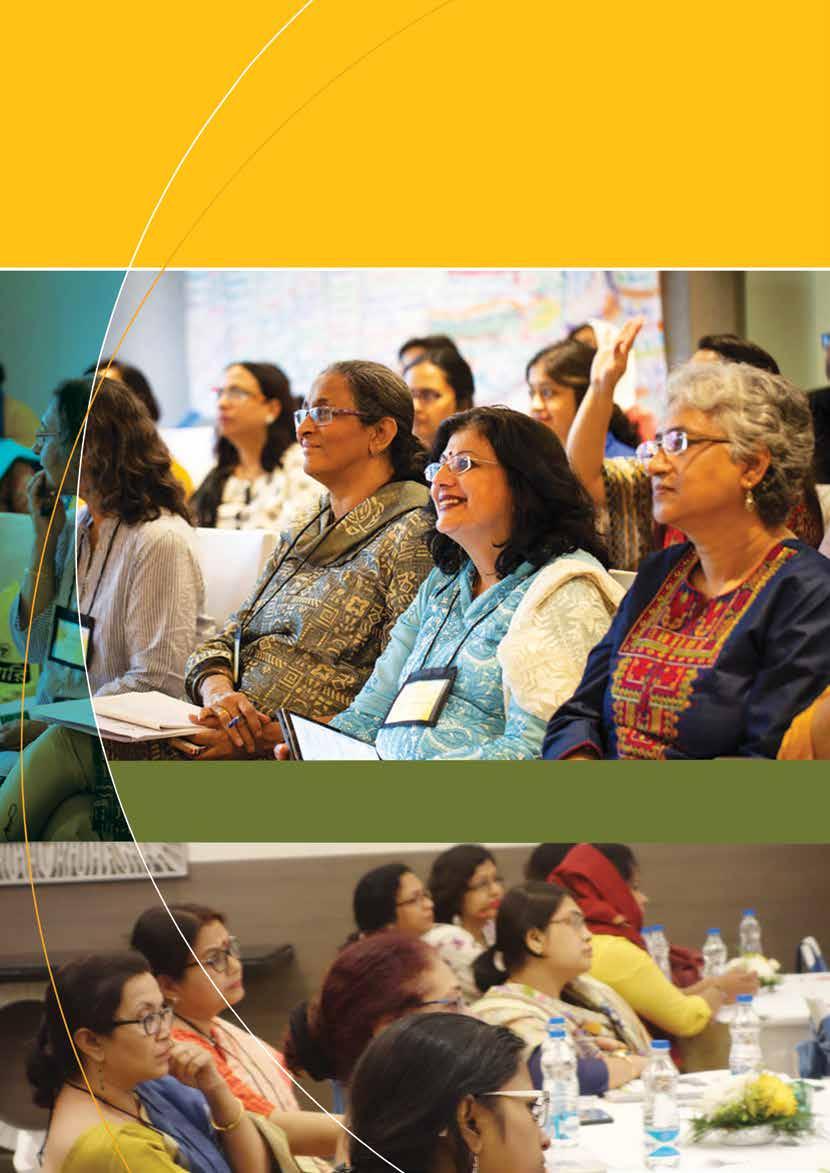
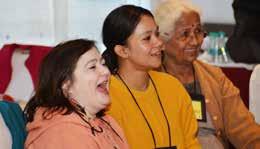
Keystone Institute India is a programme launched by Keystone Human Services International, USA and it provides extensive consultation and education around developing responsive, effective, and inclusive supports to help move toward belonging, acceptance, and a rich community life, especially for people with developmental and psychosocial disability and their families. Together with forward-thinking allies across the country, we are working to develop an inclusive society, where all people belong and are invited to participate in all the community has to offer. We believe that diverse and welcoming communities experience the gifts of all their members, and that such communities have much to teach us about how to live in harmony together.
We hold important values when it comes to assisting people with disability to lead dignified lives marked by belonging, freely given relationships, personal growth and richness. This commitment, shared with our partner the Rural India Supporting Trust, led to the launch of Keystone Institute India in 2016, a valuesbased national training institute to facilitate broad-based approaches to elevating the possibilities for people with developmental and psychosocial disability to lead full and rich lives.

9 We develop and prepare emerging leaders to work toward integrated community development instead of segregation.
9 We offer intensive workshops and presentations on promising practices and ideas, consultation, and guidance in implementation strategies.
9 We connect organizations and people throughout India and the world who are doing promising work to assist people with disability to take their place in society.
9 We conceptualize and help design responsive service models based on a model coherency framework and stakeholder collaboration.
We strive to serve as a catalyst for developing a service system in India that better safeguards vulnerable people, respects the voices and perspectives of people with disability and their families, and facilitates India’s movement toward a society where all people can explore their possibilities and reach their potential. From our deep experience, we know that inclusion benefits everyone. We have a vision of an inclusive world where all people belong, and each person can shape their own life according to their personal goals. Choice matters. Dignity of risk makes a difference. We do our job best when we listen to people’s voices and add our voice to the growing movement for inclusion for all people:
9 We offer access to world-class and national experts on inclusive practices and idea sets which support and promote a full community life for all people.
9 We seek those across India with passion and know-how to join together towards change.
9 We mentor and develop next-generation leadership to take the ideas forward and put them to good use.
9 We promote full citizenship and voice for people with disability and their families to experience full, rich, included lives.
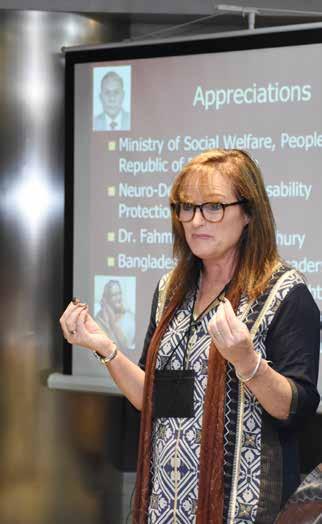
Keystone has purposefully kept our own staff small, as our strategy has been to build strength and competency across India through the development of Communities of Practice. Mentoring and coaching to develop masterful teachers in idea sets, as well as masterful implementation, has led to both a strong national collaboration of leaders as well as a regional and state collectivity committed to working together and separately for change. a CoMMItMent to CoMMunIty
We have a passionate belief that the institutionalization of people with disabilities in segregated facilities must be resisted, and that communitybased services must be developed in conjunction with public and private organizations which share that commitment. Besides providing consultation and training across India on creating high quality residential service, Keystone has joined with service not only to the women, but to the community that has been enriched by their presence.
Keystone makes sure that the ideas are translated into action, on the societal level, the community level, the organizational level and the family/individual level. After all, we teach powerful idea sets which people need support to interpret and use.
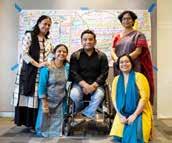
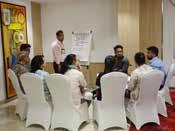

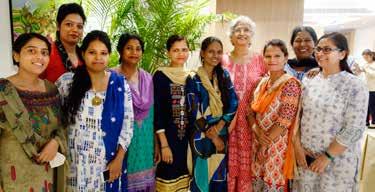
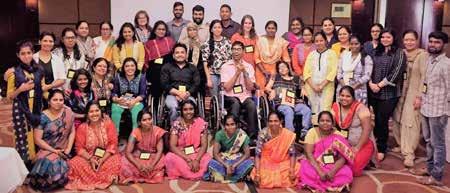
We believe that everything must contribute towards building capacity and effecting lasting change. This goes well beyond just training. Partnerships with government are a part of strengthening the fabric of the support network across India to elevate and safeguard the lives and wellbeing of people with disability.
Leadership development is another important strategy to develop lasting change, and we focus a great deal on cultivating leaders and master trainers across the country. As well, strong collaborative relationships have been developed amongst the networks of leaders.
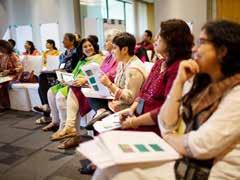
Keystone Institute India takes the work of developing a more inclusive Indian society as a serious responsibility and holds that responsibility with great care. We share a belief that people with disability have a great deal to teach society about how the world can ‘work’ for everyone.
Face-to-face events are held across the country, and our complete schedule can be found on our website. Join the national conversation around Social Role Valorization, person-centered support, tools for inclusive practice, customized and supported employment, and best practices in residential support.
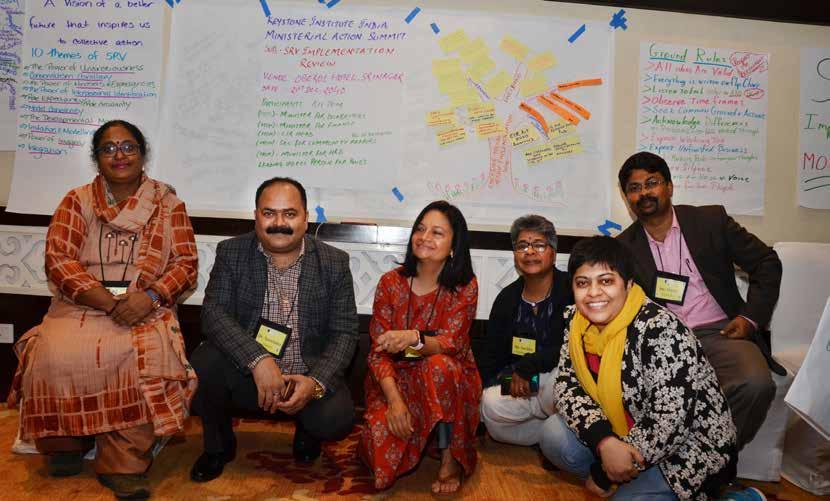
Virtual on-line events and study groups are another way to connect with our network.
See Jhalak, an online compendium of the small but potent changes that people and organizations have put the ideas we promote into practice.
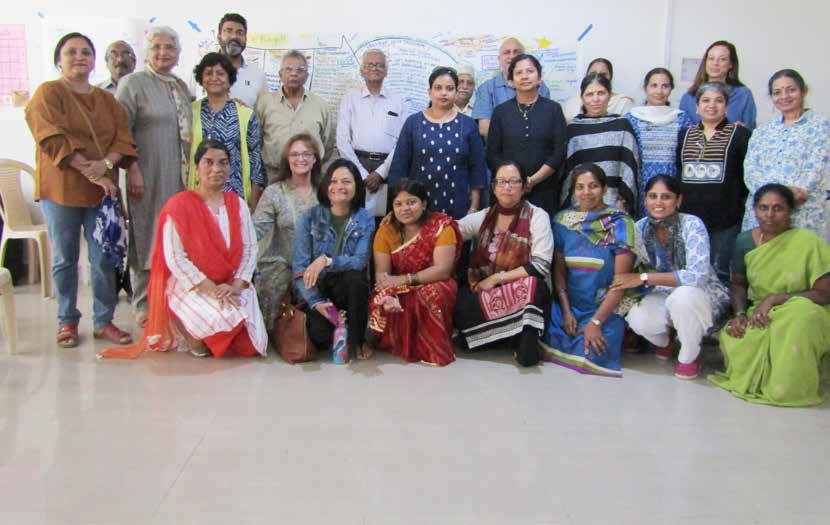
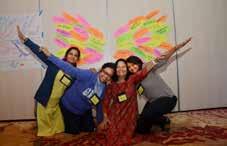



Ms. eLIzabeth “betsy” NeuvILLe Executive Director eneuville@khs.org

Ms. Geeta MoNDoL Director of Community Programs gmondol@khs.org

DR. IMRaN aLI Director of Administration mali@khs.org

Ms. LeeLa Raj Project Leader Curriculum Design, Customized Employment and Advocacy lraj@khs.org
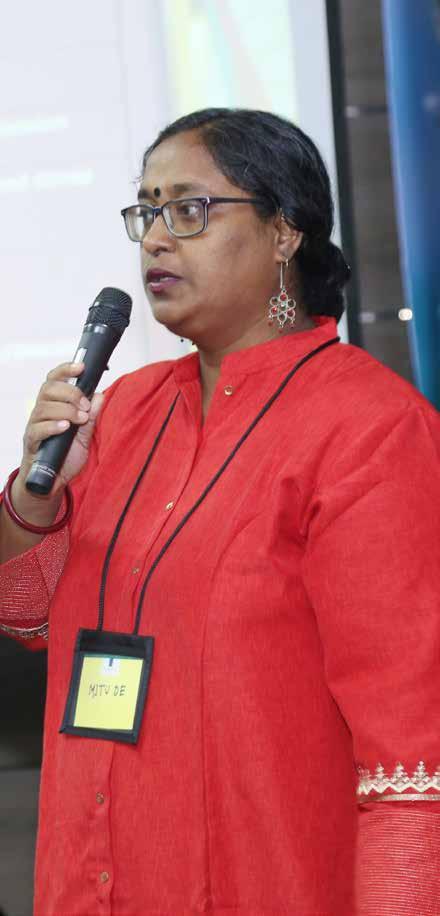
“Community is much more than belonging to something; it’s about doing something together that makes belonging matter.”
- Brian Solis
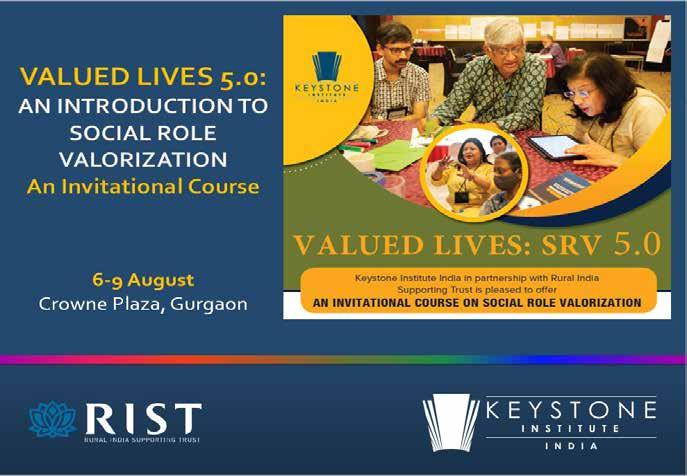

The enablement, establishment, enhancement, maintenance, and defense of valued social roles for people –particularly those at value-risk by using, as much as possible, culturally valued means


Home
School
Work Relationships Recreation/Leisure Spiritual
The attribution of low, or even no, value to a person or group
By another person or group
On the basis of some characteristic
12. Loss of natural, freely-given relationships and substitution of artificial “paid” ones 13. De-individualization 14. Involuntary material poverty
15. Impoverishment of experience, especially that of the typical, valued world
16. Exclusion from participation in higher-order value systems 17. Having one’s life wasted
18. Brutalization and “Death-making”
19. Awareness of being a source of anguish to those who love one
20. Awareness of being an alien in the valued world, deep personal insecurity
The attribution of low, or even no, value to a person or group
By another person or group
On the basis of some characteristic (usually a difference)
Devaluation is not the same as:
Being rude, impolite, discourteous
Disliking a person
Making demands upon a person
Wealth, material prosperity, material goods
Health & Beauty of body
Youth, newness
Competence, independence, intelligence
Productivity, achievement
Individualism & unrestrained choice
Hedonistic / sensualistic pleasure
Wealth, material prosperity, material goods
Health & Beauty of body
Youth, newness
Competence, independence, intelligence
Productivity, achievement
(Adult) individualism & unrestrained choice
Hedonistic / sensualistic pleasure
Non-Human A. Not Yet Human
B. No Longer Human
C. Sub-Human: Animal, Vegetable, Object D. “Other”, Alien
VirtueSin / Diabolicness / Evil
Irresponsibility
Criminality / Corruption
Pity / Charity
Attractiveness
Ugliness / Disorder
Darkness / Blackness / Shadow
LifeRelated Illness / Death
Incapacity/Impairment/Weakness
Cold
Old
Decay
Subhumanity
Incompleteness / Brokenness
Quality/ Place Poverty
Dirty
Bottom / Down / Low
Back Left Last, End Out
Worthlessness / Discardable
Virtue / Angelicness / Divinity
Responsibility
Lawfulness / Morality
Respect / Entitlement
Beauty / Order
Light / White / Bright
Health / Vitality
Strength / Power
Warm
New / Youth
Growth
Humanity
Wholeness / Completeness
Wealth
Clean
Top / Up / High
Front / Forward
Right
First, Beginning In Value
Institution for people with mental illness
Day Care Center for children with developmental disabilities
Home for neglected or abused youth
Children’s treatment facility
Hospital for children
Rehabilitation Group Home
Drop-in/ Day Center for people who are elderly
Alcoholism Clinic
High rise for the elderly
Regional center for People with mental illness
Submarine sandwich shop staffed by people with developmental disabilities
Name
Battey State Hospital
Looney Day Care
Whipper Home
Dysfunctioning Child Center
St. Jude’s Hospital
Last Chance House
Bleak House
Bahr Treatment Center
Toomey-Abbot Towers
Madden Zone Center
The Subnormal Sandwich Shop
Home for newborns and children with disabilitiesHoly Innocents, Inc.
1. Using value-tainted locations and facilities
2. Grouping devalued people in image-impairing ways to each other
3. Applying value-impairing methods, activities and structures to devalued people
4. Giving devalued people comical, bizarre or negative names and labels
5. Giving comical, bizarre, names and logos to agencies and services to devalued people
6. Neglecting the personal appearance of people
7. Funding services to devalued people with image-tainted monies or devaluing appeals
1. Being scapegoated for anything bad that has happened
2. Being suspected of belonging to more than one devalued group
3. Being cast into more than one deviancy role
4. Being treated worse for an offense than are valued people
5. Upon being vindicated, receiving less restitution
A. Physical Exclusion
B. Physical Segregation: Separate Facilities and Groupings, Institutions, Ghettos, Reservations
C. Physical Confinement: Prisons, some Institutions and Nursing Homes
D. Physical Ejection: Banishment, Expulsion
E. Physical Destruction: Deadly Assault, Capital Punishment, Abortion, “Euthanasia”, Genocide
A. Avoidance of Interactions
B. Using Language and Negative Imagery for Social Degradation:
1. Age Degradation
2. Status-Degradation
1. Being made/ kept in dependency to Individuals, Agencies, or the Service Structure generally 2. Having to Deal With, and Report to, Offices, Agencies, Authorities
Having to Fill Out Forms –often without being able to cope with such
1. Often, the cause of a devalued person’s physical discontinuity is rejection by those in control of the person
2. Devalued people get moved around much more often even within the same locale, agency, and facility
3. Devalued people frequently get moved:
A. Against their will and without their consent
B. With little or no prior notice
C. As “punishment”
4. Devalued people commonly get moved in ways and for reasons which are chaotic or bizarre, but which are almost always interpreted as being “for their own good”
5. As a result of a discontinuity, a devalued person’s situation is more likely to worsen than improve
6. Devalued people have few possessions to connect them with the places where they have been, and/or are often unable to bring possessions with them when they are moved
7. Devalued people often do not have the resources and competencies of valued people to cope with discontinuities, and to maintain contact with places where they have been, and with people in those places
Disorientation, confusion, and therefore, lowered performance
Insecurity
Loss of possessions
Relationship Loss
Stress, often leading to illness and death
1. Widespread negative societal attitudes towards poor and otherwise devalued people
2. Oppression and exploitation of devalued, weak, powerless, poor, and disabled people by powerful and wealthy interests
3. Exclusion of devalued people from societal participation and benefits, in good part via segregation and congregation
4. Unemployment built into the economy in order to keep it stable
5. Teaching and reinforcement of dependence and low competence in devalued people by society and human services
6. Systematic societal patterns of transferring wealth from the lower to the upper social strata
1. Systematic Medicalized Abortion of Impaired Unborns 2. Active or Passive MedicalizedKilling of Impaired Newborns 3. Increasing Move Toward Withholding / Withdrawing of Medical Supports from Long-Term Medically Dependent People 4. Systematic Withdrawal of Healthcare from the Poor

5. Systematic and Large-Scale Placement of Devalued People on Prescription Psychoactive Drugs
6. The Abandonment of the Ghetto Populations to Street Drugs
7. “Dumping” of Disabled People into Unsupported and Abandoned Community Living, where Such Persons can End Up on the Street, in Jail, and Victims of Violence
8. Systematic Promotion and Facilitation of Suicide by Troubled and Dependent People
Searching for the abandoner
Fantasy & inventions about positive relationships that do not exist
Seeking physical contact, perhaps insatiably
Testing of the genuineness of personal & social relationships
Withdrawing from human contact, perhaps even from reality
Turning the hurt into resentment/hatred
Rage, perhaps violence, at the world or self
A sapping of energy –both physical & mental
1. Some wounds are struck by nature, but all can be inflicted by people
2. Being devalued places one at highest risk of suffering any or all the other wounds
3. Not all wounded people get devalued
4. There is much universality about the wounding process & its transaction
5. There is a predictability about the sequence of wounds
6. Few people are conscious of the wounding dynamics and their consequences
7. People do not appreciate the role of human services in wounding
A. Being devalued often puts one into human services
B. Human services play a huge role in inflicting wounding experiences
C. There is vast unconsciousness & denial in human services about the wounds and the human service contribution to them
D. The public often sees the wounds differently than people in human services
8. The cycle of wounding also damages society and the wounders
9. Wounds must be deeply understood in order to take action on them.
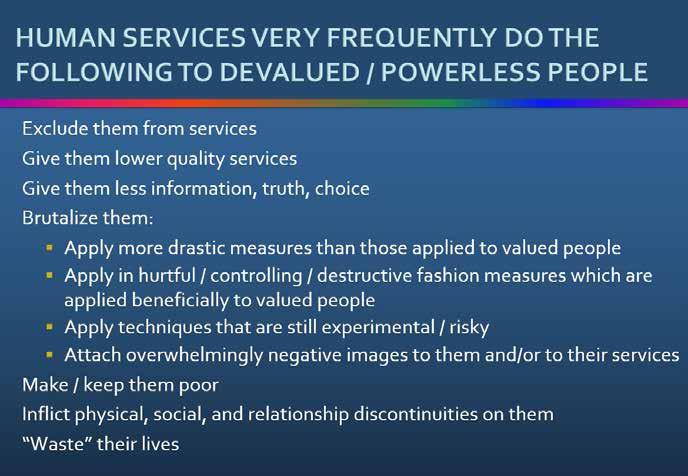
1. An entire class in society is systematically and severely mistreated by the majority or ruling class
2. The mistreatment virtually always involves:
a. Impoverishment
b. Denial / Diminishment of political voice and power
3. Over the long run, most members of the class at issue experience a quality of life that is much below that of those who are not mistreated
1. To change perceptions of perceiver so positive social judgments will be made
2. To assist people with a devalued status to have a full and meaningful life –“The good life”

A social role may be defined as a socially expected pattern of behaviors, responsibilities, expectations, and privileges
Observer, deeply influenced by various factors
Observer’s own characteristics & experiences, including expectation from previous contacts with observed person/group
Characteristics of observer’s physical environment (e.g., deprivation, stress)
Characteristics of observer’s social environment (e.g., values, expectations, norms, conventions)
Person/ Group observed
What is actually observed (i.e., another person’s/group’s “appearance”or behavior

Image in eyes of others –status and reputation
Image in own eyes –self-image
Acceptance and belonging
Associations and relationships
Autonomy and freedom
Personal growth and development
Opportunities
Material side of life
Lifestyle
The enablement, establishment, enhancement, maintenance, and defense of valued social roles for people by using, as much as possible, culturally valued means

The application of empirical knowledge to the shaping of the current or potential social roles of a party (i.e., person, group, or class)
primarily by means of enhancement of the party’s competencies & image
so that these roles are, as much as possible, positively valued in the eyes of the perceivers.

Culture-appropriateness / Cultureinappropriateness
Age-appropriateness / Age-inappropriateness

A. Which can be encountered with reasonable frequency in the valued sector of society.
B. With which most members of society would be familiar.
C. Of which most members of the society would hold most positive expectations.
In other words, “What happens for people who have a societally valued status?”
(From Wolfensbergerand Thomas, 1983)
Level 1: The individual
Level 2: The primary group: family, communality, any small close-knit group
Level 3: Secondary social systems: neighborhood, local community, service agency
Level 4: The society, either as a whole, or at least in broad cross section
1. Conflicts between higher ideals and baser drives result in repression into unconsciousness of impulses and beliefs judged as “unworthy”
2. Much learning is unconscious
3. Gradual attrition over “generations” in the conscious interpretation and affirmation of rationales for practices
4. The more complex a phenomenon is the less intelligible it is to humans
5. The natural tendency of formal organizational processes is toward lowered consciousness
6. Systematic modeling, even exaltation, of unconsciousness and systematic extinction / punishment of consciousness
A. To human nature:
1. Fear of the unknown
2. As part of “tribalisms” that support internal cohesion at the cost of defining outsiders as deviant
3. As part of the social stratification encountered in all societies
B. The price of social order rests on negative interpretation of people who violate others and the law
I. Need for attainment of identity and security by defining and defending the self in terms of what constitutes:
A. Humanness
B. Worth
C. The social boundaries of society and social groupings and what lies beyond
II. Stratification, status, and privilege, especially in the realm of:
A. Economics, which commonly means that some people must be made / kept poor to assure that:
▪ Rich can stay rich
▪ Poor will perform necessary but unpleasant chores
▪ Livelihood of “deviancy makers” is assured
B. Class, status and power enhancement, regardless of economic advantages
III. Need for tension release, especially in times of stress, by:
A. Explaining phenomena that are complex, and possibly otherwise unintelligible, as having been caused by “deviant” people
B. Legitimizing mistreatment of those blamed, thereby releasing frustration
II. Many religious and socio-political ideals to which people assent prohibit the devaluations that flow inevitably from the negative interpretations
III. This leads to a clash between people’s ideals and their true feelings and actions
IV. In order to resolve this clash, devaluing sentiments judged unworthy by the idealized conscience are driven “into hiding” in the unconscious
V. Unconscious repressed feelings ceaselessly press for release
VI. If not expressed directly, they inevitably emerge indirectly (e.g., symbolically) BAD

A proposition that follows from another that has already been proved; an inference or deduction; anything that follows as a normal result
Making available the most valued option on behalf of a person who has a devalued status
I. Most people have at least some wounding experiences in their lives.
II. However, there are some crucial differences between valued people and devalued people
A. Devalued people exist in a state of “heightened vulnerability”
1.They may be members of a group or class that is collectively, stereotypically devalued
2.Many have experienced long-standing wounding and degradation
3.They may have never been accorded valued status or class
4.They are more likely to suffer multiple wounds and stressful lives
5.They are likely to continue to be subjected to relentless, repeated wounding, to the point of deathmaking
B. Wounds inflicted on vulnerable parties have much more serious, long-term, pervasive impact than the same wounds inflicted on a relatively non-vulnerable party
C. Some practices that are normative (or even enhancing) to people of the valued culture may be harmful if engaged in by a devalued / vulnerable party because the measure in some way further heightens that party’s initial vulnerability
1. The more vulnerable a person is, the greater is the need for, and the positive impact of:
A. Preventingadditional wounds
B. Reducingexisting devaluation, impairment, or other vulnerability
C. Compensate –even “bending over backwards” –to balance off the vulnerability or devaluation
2. When there is a range of options for enhancing social image or personal competency (or alleviating vulnerability) the more valued and least “risky” measure is the adaptive one.
LESS COMMON, AND NEGATIVELY VALUED
STATISTICALLY COMMON
TYPICAL PREVALENT
LESS COMMON, BUT HIGHLY VALUED
1. The most valued option may not be feasible
2. Valued measures for valued people can sometimes become devaluing when applied to already devalued / marginalized people
3. The value attached to certain measures sometimes varies according to context
4. Some measures may conflict with each other in certain situations
People who identify with others will generally:
Want good things for the others
Want to be with the others
Communicate good things about the others
Want to please the others; do what they ask
Possibly want to be like them
1. Getting privileged people to see themselves in people who are devalued or at risk
2. Getting devalued people to identify with persons of adaptive identity, and look to them as models
1. Improving the approachability of each party by the other
2. Improving the likelihood that when contact occurs, it is positive
3. Finding and emphasizing commonalities shared by the parties
4. Engaging each party in experiences will help them see the world through one another’s eyes
5. Fostering each party’s sense of responsibility for one another
6. Engaging in shared experiences, particularly intense shared experiences
First Impressions
Experienced early in life
Intense
Confirming of earlier stereotypes
Dramatically counter to expectations
















1. Help people at risk of devaluation avoid becoming trappedin negative role circularities
2. Embed persons at risk into positive role circularities
3. Help people who are trapped in negative role feedback loops to break out of these
4. Help such people to enter positive role circularities
1. A person is in a new/ unfamiliar situation
2. There are positive role models in the environment
3. The people giving the role expectancy messages do so with authority and expertise
1. Imposing inconsistent roles on a person
a. Within a service
b. Between or among services
2. Taking away devalued people’s meaningful and positive roles
3. Imposing roles mainly to benefit
a. Other people
b. The service
4. Imposing destructive roles
5. Inappropriately taking roles away from people that they may be afraid to give up
1. The devalued person’s role models are likely to be mostly devalued / negative ones
2. Almost all environments for devalued people convey negative role expectancies
3. The devalued person is apt to receive negative role messages from almost all the people s/he encounters
4. Devalued people have usually been socialized into negative roles over a long period of time
5. The devalued person may feel very insecure in any other role other than a familiar (negative) one
1. Practice consciousness of the meaning and use of role communicators
2. To the degree that a person has been role-diminished, try to bestow positive roles or role elements
3. In new situations:
a. Immediately impose positive, demanding expectancies
b. Have positive role models in place
4. Associate persons who have been role-diminished with people in high-status roles
5. Choose and support roles which confirm a person’s positive / special identities, talents, gifts
6. Add value to roles by Clarifying and recognizing positive elements in each person’s role(s)
7. Construct roles and role communicators of / for service workers

















1. An image message enlarges or reinforces a pre-existing mind-set, stereotype, expectancy
2. It is conveyed by multiple communication channels
3. It impacts on the unconscious of receivers
4. It is sent out relentlessly
Characteristics of the Physical Setting:
Internal &/or external appearance aspects:
▪ Harmony with neighborhood
▪ Consistency with culturally valued analogue
▪ Beauty, upkeep, & seasonal appointments
▪ Age-appropriateness
Location / Proximity
History
Social Juxtapositions, Associations, & Groupings:
People served, perhaps as clients
Paid or unpaid servers: staff, volunteers, others
Personal Imagery:
Appearance
Possessions
Autonomy and Rights
Language:
Personal names and labels
Service names and labels
Setting and location names
Activities, Time Use, & Rhythms:
Types of activities and services
Combination / Separation of functions
Schedules and routines
Miscellaneous Service Aspects
Administration and law
Funding
Symbols and logos
Cultural expectations & stereotypes 3-WAY MATCH
The age of a person or group
The activities & activity timing of a person or group
1. There is a great deal of unconsciousness, and relatively little consciousness, in all human endeavors
2. Symbolic communication is very “primitive” behavior, with many symbols deeply rooted in the “collective unconscious”
3. Totality of what symbols used to mean and therefore the messages they still carry, is often unknown or forgotten
4. Inconsistency in beliefs or values leads to repression of less “noble” belief of value; whatever is repressed in unconsciousness seeks expression, usually symbolically
5. Symbolic communication is often directed towards the receiver’s unconscious
6. Even when they impact strongly, symbolic communications are difficult to decode (in part because of all the above) and are therefore
1. Expresses social devaluation largely in the realm of the unconscious
2. Teaches that a group should be devalued:
a. Massively, to many people
b. Over generations
c. In a way that can still allow people to continue to give lip service and token obedience to higher ideals
3. Ensures that devaluation will never be fully recognized and rooted out, even within any one individual
4. Confirms devalued status of victim(s) in their own eyes and those of society
5. Legitimizes Distantiationand segregation
6. Freezes devalued people into negatively valued and competencydiminishing roles
7. Legitimizes, and even invites, brutalization, even genocide, of negatively-imaged persons / groups
8. Enables real social policies of devaluation, hatred and oppression to be perpetrated, despite recurring efforts to remediate the victims’ plight
9. Raises a lot of money
1. Image issue doesn’t exist; negative juxtapositions are coincidental or selectively publicized
2. People do not notice images
3. People do not respond to imagery
4. People should not notice or respond to (negative) imagery, and therefore, imagery need not be addressed
5. Image enhancement of devalued people is “merely cosmetic” and thus lacks reality or import, or is even phony
6. There is no connection between deviancy imagery and other devaluations of devalued people
7. Benefits of some negative images far outweigh the cost (e.g., in fund raising)
I. Fundamental, often unconscious assumptions and theories about:
A. The nature of the world and the meaning(s) of life
B. The nature of human nature
C. Problem parameters
1. Definition
2. Cause(s)
3. “Solutions”
II. The people receiving the service
III. The program “content” (i.e., what is given or done to the people)
IV. The program “processes” (i.e., how the content is rendered):
A. Methods used, including setting
B. Language adopted and used in and about the service and to and about the people
C. How people are grouped to receive the content
D. Identity of the servers (i.e., the “workers”)
Who are the people to be served;
What do they need;
And how should what they need be delivered:
Using what methods,
In what settings,
In what kind of grouping,
By what servers,
& how should all of this be talked about?
Dir ections of Coher ency
Methods Gr ouping
Wor kers Langua ge Setting Identity & Needs
1. Relevance: Precise matching of service content to recipient’s needs
A. Major issues and needs are correctly identified and addressed
B. Wherever a measure tries to address the needs of more than 1 person, relevant focus for each person is preserved
2. Potency:
A. The most effective processes are used for conveying a content
B. A recipient’s time is used with intensity and efficiency
Relevance:
What Do Recipients Need?
What Do They Need More than Other Things?
Are They Getting It?
Potency:
What Are the Most Powerful Ways of Delivering the Content?
1. Relevance: Precise matching of service content to recipient’s needs
A. Major issues and needs are correctly identified and addressed
B. Wherever a measure tries to address the needs of more than 1 person, relevant focus for each person is preserved
2. Potency:
A. The most effective processes are used for conveying a content
B. A recipient’s time is used with intensity and efficiency
3. In implementation, no avoidable harm is inflicted
Bodily integrity & health, and the capacity to protect & maintain these
Bodily competence: strength, agility, stamina
Self-help skills
Capacity to project a positive personal appearance
Communication
Intellectual ability, skills, habits & disciplines
Motivation, initiative, and drive
Competent & responsible exercise of personal autonomy & control
Adequate volitional control over one’s impulses & movements
Confidence, self-possession
Social & relationship competency
Unfolding & expression of self, individuality
I. Humans achieve greater well-being via consciousness, activity and engagement, than via idleness, incoherency, alienation
II. Human being have vastly more growth potential than is:
A. Realized by most people
B. Elicited by many role definitions and expectation and by most human services
C. Apparent in a specific individual: The full growth potential of a person cannot be predicted; it only becomes apparent when the person’s life and growth conditions are optimized

1. Challenge, not mindless, endless pleasure
2. Work, not idleness
3. Work that can be understood
4. Meaningful relationship to
a. One’s origins, belongingness, sense of continuity about one’s life
b. Stable primary groups, not transient alliances
c. The larger culture
5. Natural consciousness of self and social processes, not a drugsustained consciousness or unconsciousness
6. Inspired commitment to society
1. Generally, a suitable service is potentially more impactful:
a. The earlier in life it is begun
b. The sooner after onset of an impairment or vulnerability it is begun
c. On people who are severely impaired, more so than mildly impaired
2. If relieved from fears, insecurity, anxieties, and other personality constrictions, people with disabilities can show dramatic gains, even in measured intelligence, anytime during their lives
3. People should be afforded the least restrictive service (i.e., neither more services nor restrictions should be imposed than that person needs)
4. Vastly more knowledge and technology exists about how to advance people toward their potential than is known by, or utilized in, any one service; therefore, no matter how good any service / agency is there exists a better way
1. The assumptions and implications of the developmental model are of universal relevance to:
a. People of all ages and degrees of ability
b. All types of services: educational, habilitation, residential, medical, correctional, etc.
2. Because developmental potential is more often underestimated than overestimated, one should always be aggressive in one’s expectations of what a person can learn, achieve, become
3. Next to sheer maintenance of life, a developmental approach / model is probably the most important requirement of a human service
4. Social Role Valorization is one of a number of embodiments of the developmental model and is probably the most systematic of these
1. Learning or Acquisition: Acquiring new skills & competencies 2. Performance: Utilizing the skills & competencies already possessed 3. Knowledge: Cognition, understanding 4. Skill: Ability to use knowledge one possesses
5. Habits & Disciplines: Things one does routinely, customarily

1. Reducing obstacles to an expanded behavioral repertoire:
a. In the physical environment
b. In the social environment
c. In/of the body
a. Directly
b. Indirectly, via prostheses and orthotics
d. In the mind: mindset, motivation, etc.
2. Actual facilitation of functionality through
a. The physical environment
b. The social environment
c. Other teaching practices
C. Use of competency-enhancing personal material supports and equipment
D. Physical setting features (as applicable) that promote person’s growth:
1. Easily accessible setting
2. Located amidst resources that provide opportunities for competency development
3. Physically comfortable
4. Competency-challenging environment that is neither over-nor under-protective
E. Promotion of establishment of culturally valued:
1. Autonomy and rights
2. Interpersonal interactions
3. Socio-sexual identity

MODEL / DEMONSTRATOR IDENTITY
One or more persons who can / will perform desired behaviors
Has characteristics that learner admires, valued, aspires to,identifies with
Actually, perhaps habitually, performs behaviors
Models, or “facsimiles” thereof, present in sufficient numbers in learner’s environment
Models / facsimiles perform behaviors, perhaps repeatedly, habitually, or exaggeratedly, while learner is attending
If necessary, learner is prompted to imitate
Learner is reinforced for ever closer approximations of demonstrated behaviors
Models may also be reinforced
Learner “rehearses” behaviors
Capacity to imitate, at least in approximation
Opportunity to imitate
Awareness of: environment; others & their behaviors; own behaviors
Open / susceptible to learning new / alternate behaviors
Positive view of, identification with love for the model
A. Failure to recognize the power of imitation:
1. Substituting an inferior pedagogy
2. Failure to recognize its power in reference to a specific group
B. Acknowledgement of its power with a specific group, but explicit rejection of its use
1. For ideology-related reasons
a. “Because the world is full of bad models”
b. Perverted individualism and relativism: “Everyone should do their own thing”
c. “It will bring competency-impaired learners to frustration, anger, or poorer self-image”

2. For management reasons: “It costs too much, is too inconvenient”, etc.
C. Perverted applications of imitation strategies
1. Presenting negative models, whether intentionally or not
2. Mistakenly reinforcing negative imitating
3. Encouraging the practice of fixating a person on the superficial imitation of an admired model
4. Abdicating all other pedagogies after bringing in good models
1. Know its power
2. Be mindful of the contributions and inspiration received from great models
3. Identify what to model
4. Interpret to relevant others what should be modeled
5. Discern good models
6. Surround others, especially vulnerable persons, with good models
7. As much as possible, protect devalued / vulnerable persons from exposure to bad models
8. In situations that are new or equivocal to the learner, have positive models in place from the start
9. Promote people’s sense of identification with persons who are good models
10. Reinforce positive imitation
11. Be a good model oneself to devalued persons, service workers, advocates, families, and the public
1. Helps eliminate life-wasting of devalued persons
a. Helping to thwart life-defining and externally imposed role stereotypes
b. Facilitating transmission of common widely-known experiences
c. Helping the acquisition of vital, life-sustaining skills
2. Enables a devalued person to perform in more valued ways
3. Natural, powerful process and thus:
a. A fairly painless way to learn
b. Generally inconspicuous and not image-tainted
Adaptive participation by a (devalued) person, In a culturally normative quantity of contacts, interactions, & positive relationships, With ordinary citizens, In normative shared activities, that are part of recognizable roles, and Carried out in valued (or at least ordinary) physical & social settings.
A. Terms with multiple meanings
B. Perversions of personal social integration
1. “Dumping” a devalued person into society
a. When the person lacks adequate abilities to cope
b. Without support systems
c. Into community areas already saturated with other (services to) devalued people
2. Denying people needed special services
3. Serving a wide variety of devalued people within the same setting
C. Concepts, which are possibly valid, but not the same as, personal social integration
1. Coordination of agencies, administrative departments, etc.
2. Co-locating of various services to devalued people
3. Locating programs for devalued people within the community
4. Using generic services non-integratively
I.Benefits to integrated (devalued) person:
(1)A.Protection of person’s welfare / safety, in that hurtful practices thrive more commonly in segregated settings for devalued people
(2)B.Enhancement of (devalued) person’s competencies
1.Services in open settings are more likely to be of higher quality
2.Greater opportunities in open settings to: a.Learn or perform, because:
(3) i.Integrated physical settings are more likely to be normative and to elicit normative behavior
(4) ii.People are likely to hold normative expectancies for those whom they encounter in more normative settings, which in turn elicits more normative behaviors
(5) iii.People respond positively to normative behavior, which is thus reinforced and strengthened (6) iv.Greater access to valued (peer) models / modeling, making appropriate imitation more likely (7) v.Typically, integrated settings afford a greater variety of experiences (8) b.Exercise autonomy, choice, freedom, and citizenship privileges (9) c.Meet a wider range of people, and form mutually satisfying relationships
C.Enhancement of (Devalued) person’s social image, via greater likelihood that: (10)1.The image of valued actors in a setting will transfer / generalize to an integrated (devalued) one (11)2.Services are more likely to be based on right rather than pity / charity
(12)D.Strengthened self-image
I.Benefits to other interested parties:
A.Benefits to person’s family and other close supportive relationships, if any
(13)1.Reduced motivation to be ashamed, to deny the person’s existence or one’s relationship to the person (14)2.Via person’s enhanced competencies and image, opportunity for more normatively inclusive (family) events and celebrations (e. g., weddings, holidays)
(15)3.Greater likelihood that the family will develop contacts with families of the non-disabled/ non-devalued assimilators
(16)1.Greater likelihood that the devalued person will contribute to society
2.With proper modeling, interpretation, and supports, integration with disabled / devalued people: (17) a.Gentles people (18) b.Broadens society tolerance of differentness (19)3.Often (but not always) cheaper than segregated settings / services
1. Idealized values of every major faith tradition(e.g., acceptance, compassion, mutual assistance, selfsacrifice, mutual submission)
2. Basic idealized socio-political values of equality and civic participation
Setting / Facility Appearance:
FACILITATOR OF PSI/VSP
1.Facility & ground sizeNormative
2.Match with neighborhoodAppearance harmonizes with neighborhood
3.Match with appearances of valued settings for conducting analogous functions
4.Physical features
5.Aesthetics
6.Appropriateness to ages of people being served
Service match with neighborhood:
Appearance congruent with that of valued analogues
OBSTACLE TO PSI/VSP
Non-normative, usually too large
Appearance clashes with neighborhood
Appearance does not match that of valued analogues
Positively imagedNegatively imaged
Beautiful, comfortableUgly, unattractive, barren
Age-appropriate design & décor
Service type harmonizes with neighborhood character
Age-inappropriate design & décor, usually too young for people served
Service type clashes with neighborhood character

Settings:
Access, surroundings, resources
Appearance, history, aesthetics
Groupings:
Size, congregation
Composition
Images (messages):
Personal appearancesWorkers
Names, labels
Activities
Symbols
Do they help or hinder social integration?
Do they invite acceptanceor rejectionby other people?
I. Address characteristics and conditions of devalued persons which are apt to elicit rejection from others, and therefore to prevent / inhibit integration
A. Reduce anxiety-and rejection-provoking personal characteristics of devalued persons
B. Encourage, develop and instill valued social habits
C. Disperse devalued people and services throughout the community and neighborhood
D. Surround with positive images
E. Foster valued social roles for devalued people
II. Help potential integrators to identify with devalued persons
A. Find and emphasize backgrounds, interests, activities and involvements that devalued person and potential integrators share
B. Pair up devalued and valued person in cooperative tasks, at which the chances of success are relatively good (e.g., board / committee work, school projects, neighborhood clean-up)
C. Request / elicit / structure satisfying, direct, personal, helping involvements by valued person with devalued persons (e.g., citizen advocacy)
III. Reward and reinforce any integrative gestures or acts by valued persons (e.g., private commendations, comments to significant others)
Large Institution
Nursing Home
Regional Center
Large Group
Residence
Small Group
Residence
Apt. Complex
Sheltered Apt.
Foster Home
Boarding Home
Own Home
Independent
Apt.
Segregated building in segregated site
Segregated building in integrated site
Several special classes in regular school
Segregated work station in industry / business
1 or 2 special classes in regular school
Integrated work station in industry / business
Generic early education
Regular class
On-the-job training
Open employment
Large segregated groups only
Segregated facilities
Small groups, segregated in generic facilities
Large group vacations
Small groups, non-segregated generic facilities
Small group vacations
Individual hobbies
Speical integrated social clubs
Individual vacations
Generic social clubs
Individual integrated activities
Special segregated transportation only
Community shopping, but only in deviancy groups
Small deviancy group
public transport
Public transport only
Individual worship in generic church
Frequent integrated community shopping
1. Person’s competencies
2. Available supports (e.g., necessary services, consultants, people)
3. Likelihood of success (e.g., are potential integration facilitators in place)
4. Likely advantages of:
a. The person
b. Assimilators
c. Other (future?) devalued persons
d. Others (e.g., family)
5. Costs to:
a. The person
b. Assimilators
c. Agency
d. Society
We are for difference: for respecting difference, for allowing difference, for encouraging difference, until difference no longer makes a difference.

Valorization of the positive roles already held by a person
Averting a person’s entry into (additional) devalued roles
Assisting a person’s entry into new valued roles or to regain previous valued roles
Helping a person to escape devalued roles
Reducing the negative roles already held by the person
Exchanging devalued roles already held by the person for less devalued new roles
1. The terms “norm” or “normative” may refer both to what is typical and what is valued
2. Each theme of SRV is, and all of its imp lications are, interrelated and mutually reinforcing
3. SRV is a psycho-social scientific theory, with strong roots both in empiricism and in positive values, that is universally applicable to human services
4. SRV is a scientifically “elegant” theory
5. Two constraints to scope and utility of SRV are:
a. It is a secular theory of empirical domain
b. Potential benefits of SRV are deeply dependent upon positivenessof cultural values
6. SRV is not the same as normalization, nor is it the same as what others say normalization is
7. Normalization, and to a lesser extent SRV, has been subject to innumerable misunderstandings, misinterpretations, and outright perversions
I.Misinterpreting SRV:
A.SRV only shapes the environment, never tries to normalize the person, and therefore does not deal with clinical services to the individual
B.SRV only / primarily shapes the person rather than:
1. The larger service context
2. Society
C.Persons who are devalued must become “normal”
D.As long as a person’s image is positive, competency enhancement is unimportant
E.As long as a person possesses competencies, image enhancement is unimportant
II.Taking one SRV element out of context, or over-emphasizing one to the exclusion of others, perhaps because of a previous misinterpretation:
A.Any behavior on the part of the devalued person, any appearance, or activity, etc. is accepted because free choice and individual differences “are normal”
B.Freedom of choice is the epitome of SRV
C.Anything can be applied to devalued people as long as it is normative for / among valued people
D.Devalued people are permitted –even encouraged –to participate in the perversions of the larger culture (drug use, sexual promiscuity, etc.)
E.Total immersion of person into all aspects of typical community life, without thoughtful regard for individual capacities or available supports
F.Tortuous avoidance of language that describes or denotes that a person or group has an impairment or devalued condition
G.Failure to recognize / utilize multiplicity of Social Role Valorizing options
III. Miscellaneous:
A.Devalued people are not devalued, or at least, one should pretend they are not
B.SRV is only another name for normalization; the 2 are the same
“Where there is passion, there is hope.”
- Wolf Wolfensberger
Our purpose is to provide national leadership for the teaching, study and use of Social Role Valorization as a unifying idea set among stakeholders across India who are seeking a more just and unified society for all people, particularly people experiencing disability.
All of those people from India and neighboring south Asian countries who have completed advanced training courses in Social Role Valorization (of at least 28 hours duration) in India taught by a senior trainer are considered members of AISRV Network. Active members will have many ways to interact and participate with the Network. Others may simply keep informed of what is happening across India and contribute as they can. Many members have a particular interest in the well-being and uplifting of people with developmental and psycho-social disability, but we welcome SRV graduates who are focused on cross-disability issues and other marginalized peoples.
! We serve as the core team of SRV Leadership across India and within south Asia
! We share information across our network about upcoming events and opportunities
! We “talent-spot” for emerging and promising new leaders
! We structure opportunities to take on activities including
y Writing and research about SRV and its use
y Developing training content together
y Learning to teach SRV
y Participate in SRV-focused program evaluation
y Forming regional or local communities of practice
y Translating SRV materials into regional languages
Collaboration: We will work together to form the leading edge of SRV teaching and use across India, using our energies to build something important together. We will consider collaborating rather than competing as a way to put our values into practice.
Role Modeling: We will strive to be excellent role models for those we mentor and lead across India
Building Developmental Capacity: We will build the capacities of a new generation of change agents across India by identifying, mentoring, cross-training, and supporting a cadre of emerging SRV leaders
who will help grow the movement. We will keep our eyes open for those who will join our work, and promote their growth and learning.
Commitment to Safeguarding SRV: We will protect the materials and their use by
! Making sure our focus within the Network is on SRV principles, and the connection to Social Role Valorization is explicit and named
! Properly attributing and citing all materials used in training or publication
! Work alongside, communicate, and share with senior trainers when SRV materials are adapted for use
Keystone Institute India serves as a resource to the group, providing the structure for leadership communication, and can offer assistance to related initiatives consistent with our mission. This means we can coordinate the national effort as well as strengthen regional Communities of Practice, and lend support to initiatives developed by group members where possible. KII will take a lead role in safeguarding the SRV material, but will not direct the AISRV Network.
The ISRVA will be coordinated and supported by a voluntary support team, which will by non-hierarchical and will work to be responsive to the needs and will of the group.
By Chitra Paul
On May 29th, 2020 Keystone Institute India hosted an SRV study group entitled ‘Tis People that Matter, in which the challenges and possibilities of helping people with developmental disabilities establish freely-given, inclusive relationships with typical people were explored. Two articles formed the basis for our rich conversation, and the following thoughtful and instructive reflection and response was written by parent activist and change agent Chitra Paul.
The paper by Jane Sherwin (Sherwin, 2011) begins with Aristotle’s quote – “The desire for friendship comes quickly. Friendship does not.” This is something I have seen happening so frequently in the lives of many children with autism that I know and interact with, including my own son. The societal lack of awareness, specific social skill competencies and a society that pushes for exclusion based on stereotype and fear of difference all play important roles in people with disabilities often lacking the richness of freely-given relationships and friendships in their lives.
Raymond Lemay’s paper titled “Social Role Valorization Insights into the Social Integration Conundrum” (Lemay, 2006) puts out a few “Roles of Thumb” for achieving Social Integration. Jane Sherwin’s paper “The Desire for Friendship Comes Quickly, Friendship Does Not: An Exploration of Valued Roles and Relationships” also talks about the implications. I am sharing below some experiences from my son’s life that connect so well to the many points mentioned in the two papers.
Small is Beautiful – This is something that was one of the reasons why the educational inclusion process worked out so well for my son.
However, I never realised it till I read the paper. And the inclusion process has been a critical part of him being able to develop relationships and a few friendships, too. Initially, when my son started school, the school itself was just starting out and had very few children, six children in the playgroup with a teacher and support staff. This small size facilitated developing strong relationships with not just the adults but also between the children. As my son is non-speaking and did not have a communication system in place at the time, there were limitations.
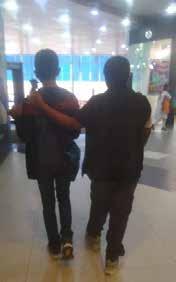
However, the teacher and the school made sure that his disability did not become the central focus. Instead they focused on helping him build relationships with his peers in whatever manner and extent possible. Some of the strategies they used regularly were to invite and welcome different classmates to help and support him, play with him, and spend time with him in all sorts of activities. The classmates included the teacher’s own daughter, who served as an excellent role model to all.
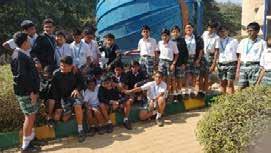
Simultaneously, academic and non-academic activities were adapted so Tarun could participate more fully. He had lots of sensory issues that were always considered when planning activities for the class. Competency building strategies were also included in subtle ways to help him gain greater confidence. These included essential communication skills, competency to use the toilet on his own, eat his food on his own, and many others. He was placed in the same classroom for three consecutive years and, having one consistent teacher further helped in better integration into school life in a natural manner like along with his peers. This set the foundation for the basis of peer interactions and friendships in the future as well.
A factor that also played a key role here is another “Role of Thumb” mentioned in Lemay’s article – One at a Time. In addition to being fully included in a small school setup that grew gradually, my son was the only child with a disability in the school for the first few years. This made it easier for everybody to include him. As he started out at the age of four years, the – Role-Person Fit – was also appropriate in the context of his lacking many skills. Many smaller children start out with skill areas not up to the developmental level, but in the smaller age groups, these tend to be overlooked or children are supported to gain competence.

As he grew in the school system, his needs changed but the school and his peers adapted to support him and include him. He was always included as an active participant in all programs that his classmates were part of. The teachers and other adults and slowly over the years, his own classmates took up supportive roles to help him be an active participant in these. The significance of him being an active participant in these were revealed to me during an activity that my son had to do for his math schoolwork. The activity was to fill in a timesheet for his life where the children had to write about the most important event in their lives for each year from when they could remember. One year, my son named his participating in the school dance in the Annual Day Programme. This was exactly as mentioned in the paper by Jane Sherwin about how task participation and relationship participation are linked to each other. Through the task participation of being active in the annual day programme, he also was able to strengthen relationships with his peers through an intense shared experience, bringing them closer.
As he has grown, gaps have widened between him and his peers in terms of developmental milestones, but that has not stopped Tarun and his friends from continuing their friendships. They have learned to communicate with him through the subtleties of non-verbal communication. They have adjusted to his many varied behaviours without passing judgement or excluding him from groups. Best of all, some of these peer relationships have grown into the next level –friendships. These friendships have a strong foundation on love and respect for him and his varied abilities. One of his friends has maintained the friendship even after changing schools, not only through social media but also meeting up in person.

The respect that I mentioned above for him and his varied abilities flows in part from his valued social role as a keyboardist. He played the keyboard for his class special assembly and soon after that also passed his London School of Music Pre-Prep exams which were put up on the school social media page and immediately, he was the talk of the school. His classmates were very pleasantly surprised and happy, and this was often conveyed to me. He does not sing but is recognised
as someone with an innate good sense of music and someone who can hold a tune through humming. He is encouraged to hum when his classmates sing thus making him a contributing part of the group. Tarun’s classmates recognise that he is a unique and interesting person, and have accepted him as different but not less.
More recently, as he is in Grade 8 now, his classmates form their own groups on social media like WhatsApp and he is always invited to be part of every group because as one of his classmates mentioned, “He is our friend.” Of course these have taken a long period of time and also efforts from multiple people who are part of his life working in coordination to achieve, but in the present time it is one of the most important aspects of his life. This clearly shows in his stated reason for liking school. When he was younger, he used to give the reason as -“because school is the best place to learn” which has over the years changed to, “because of my classmates and teachers”. Clearly, the importance he gives to these relationships and friendships in his life has grown in the ways that are expected of typical teenagers.
“Tarun’s classmates recognise that he is a unique and interesting person, and have accepted him as different but not less.”
In addition to the school space where a great many relationships and a few friendships have been forged for my son, we have also worked to craft relationships with extended family members, neighbours, our church and also a few other specific instances in different spaces.
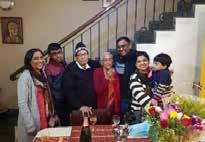

Within our family, we have always attempted to ensure that Tarun is a part of every family get together and every other function that we attend. We understand that we must expose him to more people so that the simple chances of forming relationships and friendships improve for him. Some of the specifics we always attempt to address towards this goal include modelling the kind of relationship he would expect from others, based on respect and acceptance for who he is rather than expecting him to adhere to all societal norms all the time. Simple things, from always seeking out his choices in the minutest things to letting him help himself rather than doing things for him. We strive to respect his choices and decisions and make sure that we stick to them. For example, if he expresses that he needs to take a break or doesn’t want to have a conversation at the moment, we encourage others to respect this and know Tarun will indeed get back to them when it ‘works’ for him. Understanding the importance of technology in friendships between young people, we have assured that he has message exchanges with his cousins and family members. Also, his augmentative communication device is always at hand for him to converse or respond, which helps people see that not talking does not mean that one does not think, feel or understand. Over time, these efforts have helped him develop some relationships that are cherished by both parties. This effort has resulted in him being valued as a family member, even in the larger extended family.
Within our apartment building community, we have sought to help Tarun form relationships as well. Although this has been a tougher task, there has been one positive result. It began with a friendship that I had developed with a woman living in the complex. She was very enthusiastic when she heard about my son and initiated having my son over to her place for an interaction with her son. I was pleasantly surprised and pleased when a relationship developed which has lasted over the years between Tarun
and his same-age neighbour. In our experience, friendly people do not always translate into friendships, but in this instance, they formed a lasting bond.
The members of our church initially were totally unaware of how to interact with my son and showed a strong mind-set of sympathy and even pity. However, over the years as many church members have come to understand him better, mind-sets have shifted. He is enquired about and missed when he does not attend church on some days. The interactions have become more directed towards him than through intermediaries like his dad and me. He has joined the Sunday school at church where he is included in all activities. This has been a more recent development in Tarun’s life, and we look towards further strengthening of these relationships.
“The road ahead is not easy as he passes through his teens and enters adulthood, but the hope is kept burning that he will have a life enriched with people who love and care for him.”
In the area of recreation, my son attends exercise class at a centre for training gymnastics. Although the classes were initiated specifically for children with autism, relationships have developed over the years. We have worked to support more integrative relationships, especially one with the same age son of the manager of the training centre. Initially, we helped to structure the relationships by asking if the young boy would help Tarun learn to skate. Through this activity, interactions extended past skating instruction, very naturally between the two of them. In fact, the younger sister has also joined this small friendship circle.
Specialized support practitioners, such as therapists, have also been a part of Tarun’s life, and another area where I have consciously attempted to help him build relationships. Surprisingly, these relationships have continued even after the therapists have moved on. Most of them still stay in touch and interact with him through social media and otherwise. One of them has become a mentor figure for him, and a very good friend.
Because Tarun communicates using typing as a medium, we felt it was important for him to interact with others who also use this means of communication. We attempted a planned interaction between my son and another young boy with autism who communicates through typing so that they could both learn and share communication strategies from each other. Since both need support in the form of communication partners to communicate, the initial meetups between us moms along with our sons. We tried hard to stay in the background and were thrilled that without much effort from our sides, the two young men gelled. Their get-togethers have continued in person and also online through video calls.
The attempt has been to expose my son to as many people as possible so that his life is enriched with relationships, a few of which could develop into friendships that last a lifetime. Towards this purpose, some efforts have been initially planned and then they have taken off on their own. Others have simply happened along the way because of optimal situations for nurturing relationships, including his presence in typical, fully inclusive community settings such as school and church. Either way, these relationships continue to help him grow into a happy young teenager. The road ahead is not easy as he passes through his teens and enters adulthood, but the hope is kept burning that he will have a life enriched with people who love and care for him.
Lemay, R. (2006). Social Role Valorization insights into the social integration conundrum. Mental Retardation, 44(1), 1–12.
Sherwin, J. (2011). ‘The desire for friendship comes quickly, friendship does not’: An exploration of valued roles & relationships. The SRV Journal, 6(2), 22–31.

Chitra dons many hats, working towards inclusion in Bangalore, where she lives, as well as nationally. Chitra is a trained special educator, a strong advocate for inclusion of persons with autism, administrator of a parent support group, and a parent mentor who passionately believes that all children with special needs have a right to a life with respect and dignity in this world. She strives to follow the saying, “Nothing for us, without us” and so advocates strongly for inclusion of the voices of people on the autism spectrum in all facets of life. She is also a mother to a 15-year old teenager with autism. With an MA gained in Special Education and Inclusion from the University of Northampton, she had a previous career as a clinical microbiologist, holding an advanced degree in Medical Microbiology.
Chitra is active as a volunteer, supporting parents of children with autism in Bangalore through support groups and resource sharing to better equip parents to support their children. She also provides individualized support to other parents, all within the context of autism.
Chitra often serves as a panellist at events and workshops, leads inclusion and autism awareness events, develops material to create awareness about autism in multiple languages, and advises organizations starting-up new initiatives. She has advanced training in the ideas of Social Role Valorization, and is a member of the All-India SRV Network.
Keystone Institute India (KII) is a values-based national training institute designed to improve the lives of people with disability across India and to fuel a change movement on a national level, working toward a more inclusive, just Indian society where all are valued and all belong. The work of KII serves as a catalyst for the development of supports, services, and initiatives, which better safeguard vulnerable people, establishes thinking which works towards full citizenship and full lives, respects the voices and perspectives of people with disability and their families, and facilitates India moving toward a society where all have possibilities and potential, and all matter. Keystone Institute India is a program of Keystone Human Services, funded by a grant from the Rural India Supporting Trust.
Keystoneinstituteindia.org
Elizabeth Neuville Keystone. Institute India; Contact: Eneuville@keystonehumanservices.org
Percy Cardozo Sangath India; Contact: Percy.cardozo@gmail.com
Dr. Mitu De Autism Society West Bengal; Contact: Mituaswb@gmail.com
Raymond Lemay
International SRV Association: Raylemay@rogers.com
ABSTRACT: Social Role Valorization (SRV) was introduced in India in a systematic way in 2016, gaining ground rapidly in teaching, implementation, and leadership development. Although teaching and implementation is still in its infancy, it has been received with strong enthusiasm and passion among those introduced to the principles and ideas. The road ahead remains uncertain with so many current challenges to the disability advocacy community, but the ideas of SRV, and more importantly their use, have great power and potential to move towards positive changes in both mindsets and well-being of people with disability and their families. This paper outlines in brief the theory of Social Role Valorization itself, the current state of teaching and leadership, as well as the use of the ideas to support people with disability to have full, rich, meaningful lives.
Keywords: Social Role Valorization, Inclusion, Valued Social Roles, Community-Based Services, Disability Rights
Simply put, the goal of Social Role Valorization is to make the good things of life available to devalued and marginalised people (Caruso and Osburn, 2011). Such good things include a home, relationships, a decent reputation, belonging, a robust self-image, opportunities, a comfortable lifestyle, and these are near universal in terms of their values across peoples and across cultures. SRV first recognizes and gives a detailed accounting of the impact of systematic devaluation on the lives of certain societal groups. These wounds of devaluation, as they are called so descriptively in SRV theory, are inflicted in highly predicable ways on individuals and groups and are very resistant to change because they are often inflicted without conscious intent to harm (Osburn, 2006). The consequences of social devaluation include the experience of profound rejection, congregation and segregation, symbolic stigmatization, de-individualisation, time- and life- wasting, and role-casting into such devastating negative roles such as object of pity, menace, garbage, eternal child, and burden of charity. The infliction of these wounds sets up entire classes of people, as well as individual persons, to experience very poor treatment at the hands of society (Wolfensberger, 2013).
Social Role Valorization postulates that such wounds can be most effectively addressed using principles that ‘work’ for typical members of society. If one studies typical society, it becomes apparent that the good things of life tend to come to people who have highly valued roles, and these, in fact, serve as a gateway for such good life experiences. In other words, valued social roles serve as a potent vehicle for many good life outcomes (Wolfensberger, 2013). This relatively simple precept forms the background for a multitude of implications about how, if one wants certain people to have the good things of life, certain things may be done which make that more likely, and certain other things will make that less likely. All of SRV is based on such “if this… then that” propositions, offering extensive guidance to practitioners, service workers, activists, and people with disability and their families (Wolfensberger, 1995).
Social Role Valorization describes how people come to be at the bottom of the social ladder, and what really works in people’s lives to lift them out of this social devaluation (Neuville, 2019). The central strategy is to help people who are entrenched in deeply harmful social roles – such as burden, eternal child, menace, sick, ‘better off dead’, human service client, object of ridicule to name a few – instead be assisted to move toward valued roles, like citizen, taxpayer, neighbour, big brother, student, employee, homeowner, amateur artist, club member. These valued roles carry great weight for all people, as they are the means through which all people gain access to important elements of life such as acceptance, belonging, a good reputation, a strong self-image, opportunities, and a full, rich life (Osburn, 2006). Services which support and assist people with disabilities to have valued social roles as a focus point seem to be the ones which provide the greatest well-being to the people they serve.
Unfortunately, many programs intended to make life better for people with disabilities tend to focus on providing activities and keeping people busy, rather than working towards positively valued roles for each person, individually, and providing activities directly related to the development of valued roles. SRV offers a fundamentally different understanding about how to guide people towards good lives. Competency development is one way to build towards valued roles – for example, assisting someone to be in the role of an amateur artist involves learning at least some of the skills needed to create art, but also involves helping someone to have the image of the role – by having the equipment, the materials, the right clothing, and be in the physical places that artists spend time. In addition, one would help a person be with the typical people in society that artists tend to spend time with.
Much more remains to be said about valued roles, their benefits, and how to support people with disability to grow into them successfully, but a deeper study of SRV can be pursued elsewhere. SRV has been referred to as an ‘elegant theory’ (Flynn & Lemay, 1999), meaning that it is a simple concept from which many programmatic lessons can be drawn. An organization does not use SRV as a checklist or standard set of practices – but if used as a base, it seems that whatever methods are used can be can be used better, more fully, and with more positive benefit and less unintentional harm if designed and carried out on a strong foundation of SRV (Caruso & Osburn, 2011).
Inclusive education will likely more truly inclusive and successful with an understanding of the power of imitation and modelling, and role circularities offered by SRV theory. All things being equal, helping people who have been rejected and isolated actually gain life-giving relationships is more likely if SRV theory is put to use. Creating community-based services that are integrative rather than segregating can be aided using SRV. It is helpful in addressing issues of service design, as well, and may result in programs that successfully meet the most pressing needs of people, and that are effective at helping people enter into valued roles successfully. SRV study and use appears to help professionals, families, advocates, and everyday citizens see more keenly the wounding experiences that disabled people must contend with, identify more closely with such people, and work more fruitfully towards better futures.
The ideas that developed and coalesced to become Social Role Valorization theory emerged in the 1950s-1960s at a time of widespread disenchantment with congregate care settings for children and adults with intellectual impairments. Residential institutions in North America and western Europe were essentially custodial, of poor quality, even dehumanizing (Wolfensberger, 1969), and not a few were the subject of negative exposés in the popular press (Blatt B., & Kaplan, F., 1974). In his history of the principle of normalization, Wolfensberger (1999) recounts that though many were in agreement that the institution had to go, it was not at all clear what it should be replaced with. There was no available organising idea to direct the establishment of a new approach to serving people with disabilities.
However, there were, here and there, attempts at change and innovation. Wolfensberger (1934-2011), while on a postdoctoral research fellowship in the early 1960s, visited cutting edge services in Germany, Switzerland, Belgium and parts of the UK and wrote up what he found (1964a-b; 1965). With the participation of many families of people with intellectual disabilities, Wolfensberger was also a leader in designing and setting up a new community service system in the state of Nebraska in the United States (Schalock, 2002), where many new service modalities were imported from Europe or were original in design.
In 1969, Robert Kugel and Wolf Wolfensberger (1969) were asked to bring together a group of leaders in the field of disability to describe residential alternatives for people with cognitive impairments. “Changing Patterns in Residential Services” to which contributed a number of the leading lights of the era, included Bengt Nirje’s (1969) first systematic description of what he was first to call the “Normalization principle” and defined it as “making available to the mentally retarded patterns and conditions of everyday life which are as close as possible to the norms and patterns of the mainstream of society.” The book and Nirje’s chapter ended up becoming quite influential. More detailed histories of normalization are available (Lemay, 1995; Nirje, 1999; Wolfensberger, 1999).
Wolfensberger further elaborated the principle of Normalization to apply to all groups of people at risk of marginalization (Wolfensberger 1970). His 1972 book on “The principle of Normalization for Human Services” was a best seller, however, the term “normalization” generated some controversy and many misconceptions (Wolfensberger, 1980). Also, Wolfensberger’s definition of it had evolved considerably with the “social role” concept becoming a key element (Wolfensberger and Tullman, 1982). In 1983, he suggested that the principle should be called something else and proposed the expression “Social Role Valorization” (SRV) as the name of a theory that reached beyond normalization. In line with his goal of defining it as a social science theory he evacuated much of the ideological content. SRV thus became a descriptive theory that elucidated how social roles were the mechanism through which devaluation or valorization was transacted, and later (Wolfensberger et al., 1996) that would emphasize how valued social roles opened up access to objective well-being or “the good things of life.”
From the very beginning, Normalization and then SRV have been very influential (Flynn & Lemay, 1999), particularly in the English-Speaking World (Canada, the USA, the United Kingdom, Ireland, Australia and New Zealand). Twenty years after its publication the “The Principle of Normalization in Normalization (Heller et al. 1991) was judged to be the most influential text on intellectual disabilities of the past 50 years. The 1983 article unveiling Social Role Valorization (Wolfensberger, 1983) was judged the 17th most important work over the same period of time (Heller et al., 1991).
The community-based service agency structure first developed in Nebraska has been widely replicated (Schalock, 2002). In 1994 the United Nation’s hosted a conference in Reykjavik, Iceland, titled “Beyond Normalization: Towards a Society for All” (Lemay, 1994a) to unveil the new “Standard Rules for the
Equalization of Opportunities for Persons with Disabilities,” that owed much to the seminal contributions of Normalization and SRV (Lemay, 1994b).
Over the past 40 years, many thousands of people around the world have attended multiday workshops that explain SRV theory. Many human service “best practices” find their origin in SRV such as support for individualisation, and autonomy and rights that are now commonplace (Caruso & Osburn, 2011). SRV’s teaching on the issues of imagery and particularly language have gained widespread adherence. Inclusion/ integration is broadly acknowledged as a primary goal of intervention, once again with SRV leading the way conceptually and through practice innovations (Flynn & Aubry, 1999). Intervenors who engage in these best practices do not always acknowledge and possibly do not even know their provenance, but they are nonetheless products of SRV. However, SRV is best practiced comprehensively otherwise applying a single best practice might end up being incoherent if the general thrust of intervention is counterproductive.
Though SRV and its concepts are well known in the Anglosphere, there are current Social Role Valorization initiatives ongoing in France, the Netherlands, Ireland, Republic of Moldova, and also to a limited degree in Japan and South Korea. R. B. Billimoria (1993) described the possible application of normalization in India, but Normalization and SRV were first written and taught about in India by Dr. Akhilesh Kumar and various colleagues, (Kumar, 2015) and with Dr. Thomas Thressiakutty (Kumar & Thressiakutty, 2012; 2020), and also an article by Saha (2017). In the scheme of things, Social Role Valorization is still a relatively new idea that continues to generate insight and innovation for those who sample its rich structure of concepts and practices.
Apart from a few UK-educated scholars and practitioners exposed to the theory, SRV was not taught or used in any sort of a systematic way in India until about 2016. A few papers were written, including one highlighting a small-scale use of PASSING (Kumar, Singh, & Thressiakutty, 2015) but it is clear that the full foundation for SRV understanding and use was not in place. In 2015, several influential partners, The National Trust, Rural India Supportive Trust, and The Hans Foundation collaborated with Keystone Institute India to support the inaugural introductory workshop in India, with highly experienced SRV international experts leading and providing the main aspects of the theory over 30 classroom hours in Delhi. In attendance were some of the most influential persons representing advocates and activists, parent leaders, and professionals, hailing from 13 states across India. The level of government and private sector support for this workshop was exceptional, especially considering that it was a leap of faith to believe that the ideas would be embraced, given that the faculty were from out of country (US, Australia, and Republic of Moldova). In fact, the workshop was well-received, and resulted many of those course graduates sponsoring a host of brief, one-day workshops across the country over the next 18 months. Course graduates were also mentored to serve as faculty and resource persons at these smaller workshops.
This first wave of SRV teaching followed the preparation of in-country faculty for intensive courses, as well as thoughtful recruitment for all courses. Most of the initial course graduates nominated their own proteges and promising colleagues to attend the second intensive course offered in 2018. As well, across India, those teaching brief courses consistently kept a list of “bright spots” attendees showing both interest and promise as future SRV leaders. All these promising people were invited to apply to the courses offered in 2018, and again in 2019. The same sort of measured and intentional follow-up was taken after each, and each workshop cohort showed more and more excitement and intention to use SRV in the lives of their sons and daughters, and the people they serve in their organizations. A high
proportions of family members gave great strength to each of the cohorts. As has been the case in other countries, there were very few people with lived experience of developmental and other disabilities participating at each intensive workshop event.
It should be said here that the formation of strong and experienced SRV educators is a committed process by those who mentor new trainers as well as those who aspire to be SRV trainers. Teaching even very brief workshops on SRV requires a much deeper knowledge of the theory and its use. It also requires much more than a theoretical grasp of the concepts and how they relate to each other. Those who teach SRV credibly must have significant experience with people with disability and their families, and have experience assisting such persons to move into valued roles. Trainer formation in is a lengthy and intentional process (SRV Development, Training & Safeguarding Council, 2005), a far cry from the typical ‘train the trainer’ events.
Some of the indicators of creating successful trainer formation process in India is that 100% of the faculty in the 2016 intensive workshop were from outside India, with admittedly little experience in-country. By the second course, named SRV 2.0 and offered in 2017, 40% of the lead trainers were Indian, and by the SRV 3.0 Course offered in 2019, fully 60% of the leadership was Indian. Each course produced significant numbers of highly motivated persons hungry for more opportunities to put the ideas to work. In 2020, the All-India SRV Leadership Network was founded with over 100 members, with a mandate to offer a platform for the development of SRV course graduates.
At the time of this writing, there continues a small but active vanguard of people across India who are engaged in a mentoring process to conduct both brief and more extended high-quality workshops covering SRV basics. These courses are designed to give a conceptual overview of the consequences of devaluation along with the utility of valued social roles in moving people with disability towards access to the good things of life – belonging, acceptance, relationships, a positive reputation, true home, personal growth and opportunity. As well, the workshops have been conducted in both Hindi and English, and give participants practical ideas and examples of implementation in the Indian context. These workshops have been helpful in exposing over 6000 people from nearly all Indian states to SRV in the first five years, and have created fertile ground for recruiting stand-out participants for further engagement with the ideas as potential trainers or implementors. A number of these referenced emerging leaders have taken advanced training in the US, and these potential senior trainers in India form the core of SRV teaching in India. In addition to developing capable and experienced SRV trainers within the country, another working group is focusing on aspects of writing and research, to generate a foundational Indian body of writing on SRV. A third thrust of activity is geared towards gaining experience in conducting SRV-based program evaluation and assessment. These two activities, alongside the development of SRV trainers, will be essential in fleshing out the understanding of SRV across India as well as the actual implementation of Social Role Valorization.
SRV principles can be applied in the life of an individual person with a disability, a family, a program or organization, or an entire society (Osburn, 1982), which gives it great relevance to any change efforts intended to benefit people with disabilities. In fact, SRV is not a method, but it is a foundational idea set which often means that methods rooted in it will be more successful and more likely to result in good outcomes in the lives of marginalized and oppressed people. As mentioned, inclusive education seems
to be more successful when an understanding of Social Role Valorization informs it, as does personcentred planning, individual educational planning, vocational and livelihood ventures, and certainly residential services (Caruso and Osburn, 2011). Across India to date, SRV has taken strongest root within numerous organizations and among thought leaders in the field of developmental disability, but especially in programs supporting people with autism. As implementation moves forward, experimental changes in program practices towards both image enhancement as well as competency enhancement have been adopted across many services. Some of these changes are being captured in on-line resources and prepared for publication (Keystone Institute India, 2020).
SRV relies on modelling the design of supports and services to what typical valued people have, do, or want, making the ideas quite sensitive to culture. Efforts to assist people with disabilities to be in the normative pathways help with integrative efforts, and access to valued roles. For example, children go to school, have standards and classes, and get together with their classmates after school. Most adults work, and if they do not, occupy their days by contributing in other ways to the society. Implementation efforts across India have focused on helping people with disability engage in typical activities, with typical people, in typical ways, in typical places, and in recognizable social roles (Lemay, 2006). The following case studies are intended to help illustrate the ways that SRV has been applied within organizations and within individual lives.
The case studies were undertaken with two organizations and one individual with a view of uncovering the implementation experiences of SRV in India. The founding members of these organisations and a guardian of the individual were interviewed. The intent of the interviews was to understand the participants’ motivations for the change, their experiences as they embarked on the journey and the impact of SRV on their organisations. The interviews revealed that although the organizations have not been able to implement all principles/elements of SRV, but they have made an excellent start. Data also showed that SRV had not only affected the organizations positively but has also influenced the personal lives of individual people to a large extent. As a start, the organizations and individuals have used SRV theory as a lens to evaluate their services delivery and interactions with people. Fictional names have been used in place of the people and the organizations.
Rani describes herself as a 21-year-old woman who loves dogs, horses, computers, travelling and cycling. She adds that people not turning up on time upsets her the most, and that she does not like her routine being shuffled. She says her family, friends and her teacher have been her greatest supports. “Keep trying and learning” is the message she wants to convey to young people like her.
Rani, whose strengths are visualisation and designing, was diagnosed with Autism at a very young age. Her mum, Ritu, reminisces that her first session on SRV was an eye opener and a life-changing experience. It subsequently led to a deeper engagement with the SRV leaders in India to plan a PATH (O’Brien, Pearpoint & Kahn, 2010) session for Rani. PATH is a creative, inclusive planning process that helps envision a future of valued roles and a plan to work towards that future. Ritu believes that elements from SRV have helped her clarify her expectations, focus on her daughter as an individual in her own right, and accept and respect her views. She liked the central focus that PATH accorded to Rani; for the first time it gave her the control of her life and the freedom to plan it the way she envisioned. This empowering experience changed her life forever; it helped her discover her goal, built her selfconfidence and enhanced her social networks. Engagement with SRV networks has helped Rani carve
a valued role for herself – that of an entrepreneur and an employer. It has allowed her to find a place for herself in society, gain respect from the community and live an enriched life.
For Rani and the team who supports her, intentionally using highly valued imagery and helping her to gain the competencies to take the lead authentically at Pumpkin Patch has been an equal effort contributing to role success.
The AF is a not-for-profit organisation established more than a decade ago catering to the needs of children and adults with autism and developmental disabilities. Their vision is to transform communities to value every individual with developmental challenges and support them to lead a fulfilling life. To achieve this, they operate an early intervention center, a special school, a vocational training center for young adults, and they extend mentoring and training supports for families, and advocate about disability issues.
AF is one of the earliest organisations in India to have embraced and adopted the teachings of the SRV theory. Its founder was introduced to the SRV network in India through one of AF’s partner organisations. Her initial brief encounter with SRV attracted her to the concept and its relevance to the organisation. She immediately got the board members, senior staff and families involved in SRV training, and requested a collaborative evaluation to discern pathways to move forward.
The first shuffle was the setup of the classrooms to diminish the wounding and the stigmatization that resulted from ‘branding’ the classes according to functional levels of students. They based the new structure on age levels, which matches the norms applied in the general education schools. Also, they embarked on a journey of ‘unlearning’ the segregating terminologies and methods by pairing up with a neighbourhood school. In this way, they studied the schedule, the curriculum, the physical appearance inside and out, and the typical language used, and matched it as best they could within AF. They created a separation between the school portion of the service and the vocational portion, so that there was normative separation between school and work, as well as young adult and child. The school aims for complete inclusion, but there are practical challenges that they have to deal with. Over the long haul, they can envision shifting to a more inclusive model, but in the meantime have shifted towards integrated, community-based learning activities, maximizing experiential learning, and increasing the potency of learning.
With a new understanding of the power of employment roles, specifically the role of employee, in-house vocational skills training was shifted towards authentic supported jobs in the community. The leadership of this organization is optimistic about the futures for the people served at AF as they move, more and more, towards using a framework of SRV in promoting valued roles. One important component been gaining the widespread support of the entire school community – board members, staff, families, and young people who access their services.
ABCS is a non-government organization working towards education, empowerment and entrepreneurship development for young people with disabilities. They are striving to enable young people with disabilities to gain control over their lives and establish financial independence. ABCS envisions a place where young people with disabilities will be celebrated as valuable contributing members of the community.
The organization holds a strong belief that financial independence is the key to improve the status of young people with disabilities. When young people earn their own ‘bread and butter’ through valued work, they enjoy a valued status in society, which will naturally allow them to enjoy some good things in life. Through a social enterprise model, ABCS reaches out to other organisations to provide support for skill-building, setting up business enterprises and mentorship. They have worked alongside a number of young people with disabilities to launch real careers. They plan and carry out image enhancement strategies in the form of community sensitization activities. In this way, they work to shape positive perceptions to enhance the status of young people with disabilities When the organization was transitioning itself to function through an SRV based approach, the biggest barrier was battling the negative attitudes that people hold towards persons with disabilities. ABCS has worked on both sides of the SRV equation. They use direct and explicit strategies to help people move into valued roles such as shareholder, colleague, tax payer, employee, entrepreneur, and trendsetter, and also work to put good things into the minds of the typical citizens of Kolkata about people with disability and their contributions. SRV has inspired their model of inclusive social entrepreneurship, which focuses on capabilities and strengths, rather than deficits.
India is a nation whose roots are steeped in diverse cultural soils. As a nation, Indians have associated a negative value to many marginalised groups viz. religious minorities, widows, poor people, individuals belonging to low castes, tribal or ethnic minorities, disabled people, refugees, migrant labourers, people with different sexual orientation, etc. An important consequence of this is that people operate within their cultural context, but are often unaware of it (Stangor, Stroebe and Hewstone, 1996). Our close environment and culture influences prejudice because members of a culture hold sets of beliefs in common, including beliefs about behaviors, values, attitudes, and opinions. Michael Kendrick mentions in one of his paper ‘throughout history, one of the great commonalities in the human condition has been our propensity to devalue one another’ (Kendrick, 1994).
The introductory course on ‘The Principles of Social Role Valorization (SRV)’ created a powerful paradigm shift in consciousness of most of the SRV graduates in India. The course was an eye opener, as it revealed how mainstream society devalues groups of people in India and how parents had preconceived notions about disability. It was particularly painful for many parents to realize how they had devalued their children or the people they served earlier, thinking it was good for them.
The SRV introductory courses and the several follow up workshops across India gave the participants the courage to question their own beliefs about disability. SRV offered a lens through which they could view their role in society. SRV taught the course graduates to question themselves. This term ‘wounding’ triggered a trail of reflective thinking among many of the anguished participants. They wondered who and how they had ‘wounded’ unconsciously.
Participants were introduced to the power of ‘valued social roles’ and how important they were so that the individual ‘experienced the good things in life’. Image enhancement and competency enhancement were discussed as the primary means of getting people into valued social roles (Thomas, 1999; Wolfensberger, 2013). Across India and some parts of Bangladesh, individuals set about implementing the Principles of SRV. The case studies are examples.
An important consequence of the SRV training in India was helping parents of individuals with disability to have a vision for their children. Of course, the obstacles that came in the way were identified and paths were envisaged either around it, or over it or through it. PASSING (Wolfensberger & Thomas, 2007) is an evaluation tool that helps take a disciplined look at the rights and wrongs of human services
through the lens of SRV. SRV theory and the PASSING evaluation instrument together provide a very useful theoretical framework and operational methodology for the analysis of the quality of human services. Mainstream & higher education, teacher training education are some of the areas where SRV, if introduced, may create a stronger foundation for inclusive strategies.
United Nations (UN) Secretary-General António Guterres said ‘When we secure the rights of persons with disabilities, we move our world closer to upholding the core values and principles of the United Nations Charter’. Inclusion exists where people are enabled to take part in the activities and roles that are part of mainstream society such as having a job (Wistow and Schneider, 2003).
The future is yet to be shaped and we all have the power of influencing it. How we perceive ourselves and others will have implications where we are heading as a society in the future. We humans share basic wants and needs that are the hallmark of humanity. It is the collective mindset of a nation which determines the future. An understanding of Social Role Valorization (SRV) can lead to an inclusive mindset which could improve the lives of people who are devalued by society.
Billimoria, R. B. “Principle and Practice of Normalization: Experiences from Sweden and application to India.” Uppsala University, Centre for Handicap Research, 1993.
Blatt, Burton and Fred Kaplan. “Christmas in Purgatory: A Photographic Essay on Mental Retardation.” Human Policy Press, 1974.
Caruso, Guy, and Joseph Osburn. “The Origins of “Best Practices” in the Principle of Normalization and Social Role Valorization.” Journal of Policy and Practices in Intellectual Disability Research, vol. 8, no. 3, 2011, pp. 191-196.
Flynn, Robert J. and Tim Aubry. “Integration of Persons with Developmental or Psychiatric Disabilities.” In R. J. Flynn, & R.A. Lemay). A Quarter-century of Normalization and Social Role Valorization: Evolution & Impact. 1999, University of Ottawa Press. 271-304.
Flynn, R. J., and R. A. Lemay. “Normalization and social role valorization at a quarter-century: Evolution, impact, and renewal.” A quarter-century of normalization and social role valorization: Evolution and impact (1999): 3-16.
Heller, H. W.; Spooner, F.; Enright, B. E.; Haney, K.; and Schilit, J. “Classic Articles: A Reflection into the Field of Mental Retardation.” Education and Training in Mental Retardation, vol. 26, 1994, pp. 202-206.
Kendrick, Michael. “Some reasons why Social Role Valorization is important.” SRV/VRS: The International Social Role Valorization Journal/La Revue Internationale de la Valorisation des Roles Sociaux, 1 (1), 14 18 (1994).
Keystone Institute India. “Jhalak: Portraits of SRV and Person-Centred Practices.” https://www.jhalak.org. Accessed 24 November 2020.
Kugel, R. and Wolf Wolfensberger (Eds.). “Changing Patterns in Residential Services for the Mentally Retarded.” President’s Committee on Mental Retardation, 1969.
Kumar, Akhilesh, R.R. Singh, & A.T. Thressiakutty. “Quality of Special Education Services in India: A PASSING Analysis.” European Academic Research, vol. III, no. 7, 2015, pp. 7331-7347.
Kumar, Akhilesh and A.T. Thressiakutty. “Social Role Valorization (SRV) A Strong Voice of Disability.” Scholarly Research Journal for Interdisciplinary Studies, vol. I, no. II, 2012, pp. 284-292.
Kumar, A. & Thressiakutty, A. T. “Impressions of Principle of Normalization on Special Education Services in India.” Scholarly Research Journal for Humanity Science & English Language, vol. 8, no. 37, 2020.
Lemay, R. “A Reykjavik Journal.” SRV/VRS: The International Social Role Valorization Journal/La Revue Internationale de la Valorisation des Rôles Sociaux, vol. 1, no. 2, 1994a, 42-44.
Lemay, Raymond. “A review of the ‘Standard Rules on the Equalization of Opportunities for Persons with Disabilities,’” United Nations Department for Policy Coordination and Sustainable Development. SRV/VRS: The International Social Role Valorization Journal/La Revue Internationale de la Valorisation des Rôles Sociaux, vol. 1, no. 2, 1994b, pp. 47-51.
Lemay, Raymond. “Normalization and Social Role Valorization.” In A. E. Dell Orto and R. P. Marinelli (eds), Encyclopedia of Disability and Rehabilitation Simon & Schuster Macmillan, 1995, pp. 515-521.
Lemay, Raymond. “Social Role Valorization Insights into the Social Integration Conundrum.” Mental Retardation Vol. 44, no. 1, 2006, pp. 1-12.
Neuville, E., Cardozo, P., De, M., & Lemay, R. (2023). Social Role Valorization Theory in India: An Idea with Consequences. In Understanding Disability: Interdisciplinary Critical Approaches (pp. 25–38). essay, Singapore: Springer Nature.
Neuville, Elizabeth. “Pathways to the Mainstream: The Promise of Social Role Valorization.” In S. Dutta & M. De (Eds.), Understanding Autism, The Asiatic Society, 2019, pp.32-46.
Nirje, Bengt. “The Normalization Principle and its Human Management Implications. In R. Kugel & W. Wolfensberger (Eds.), Changing Patterns in Residential Services for the Mentally Retarded. President’s Committee on Mental Retardation, 1969, pp. 179-195.
Nirje, Bengt. “How I came to formulate the Normalization Principle.” In R. J. Flynn & R. A. Lemay (1999). A Quarter-century of Normalization and Social Role Valorization: Evolution & impact. University of Ottawa Press, 1999, pp. 17-50.
O’Brien, John, Jack Pearpoint, and Lynda Kahn. “The PATH and MAPS Handbook.” Person-Centered Ways (2010).
Osburn, Joseph. “An Overview of Social Role Valorization Theory.” The SRV Journal, vol. 1, no. 1, 2006, pp. 4-13.
Schalock, R. L. “Out of the Darkness and Into the Light: Nebraska’s Experience with Mental Retardation.” AAMR, 2002.
Saha, Shagnik. “Difficulties and Exploitation in Inclusive Schooling: In-Field Reflections in Mental Disorder/Disability Inclusion in India.” Journal of Psychosocial Research. Vol.12, no.2, 2017.
Stangor, Charles, et al. “Influence of student exchange on national stereotypes, attitudes and perceived group variability.” European Journal of Social Psychology 26.4 (1996): 663-675.
Thomas, S. Historical Background and Evolution of Normalization-Related and Social Role Valorization-Related Training. In R. J. Flynn and R. A. Lemay (Eds.), A Quarter-Century of Normalization and Social Role Valorization: Evolution and Impact (pp. 353-374). University of Ottawa Press, 1999.
SRV Development, Training & Safeguarding Council. A Brief Overview Of The North American SRV Council’s Trainer Formation Model (2005).
Wistow, Richard, and Justine Schneider. “Users’ views on supported employment and social inclusion: a qualitative study of 30 people in work 1.” British Journal of Learning Disabilities 31.4 (2003): 166-173.
Wolfensberger, Wolf. “Some Observations on European Programs for the Mentally Retarded. Mental Retardation, vol. 2, no 5, 1964, pp. 280-285.
Wolfensberger, W. “Teaching and Training of the Retarded in European Countries.” Mental Retardation, vol. 2, no. 6, 1964, pp. 331-337.
Wolfensberger, Wolf. “General Observations on European Programs.” Mental Retardation, vol. 3, no. 1, 1965.
Wolfensberger, Wolf. “The Origin and Nature of our Institutional Models.” In R. Kugel & W. Wolfensberger (Eds.), Changing Patterns in Residential Services for the Mentally Retarded President’s Committee on Mental Retardation, 1969, pp. 59-171.
Wolfensberger, Wolf. “The Principle of Normalization and Its Implications to Psychiatric Services.” American Journal of Psychiatry, 127, 1970: 291-97.
Wolfensberger, Wolf. “The Principle of Normalization in Human Services.” NIMR, 1972.
Wolfensberger, Wolf. “The Definition of Normalization: Update, problems, disagreements and misunderstandings.” In Normalization, Social Integration, and Community Services. (eds). Robert J. Flynn and K. E. Nitsch. Baltimore, 1980.
Wolfensberger, Wolf. “Social Role Valorization: A proposed new term for the principle of normalization.” Mental Retardation, vol. 21, no. 6, 1983, pp. 234-239.
Wolfensberger, Wolf. “A Contribution to the History of Normalization, with Primary Emphasis on the Establishment of Normalization in North America between 1967-1975.” In R.J. Flynn & R. Lemay (Eds.), A quarter-century of normalization and Social Role Valorization: Evolution and impact. University of Ottawa Press, 1999, pp. 51-116.
Wolfensberger, Wolf. “An ‘If This, Then That’ Formulation of Decisions Related to Social Role Valorization As a Better Way of Interpreting It to People.” Mental Retardation, vol. 33 no. 3, 1995.
Wolfensberger, Wolf. “A Brief Introduction to Social Role Valorization: A High-order Concept for Addressing the Plight of Societally Devalued People, and for Structuring Human Services” (4th ed.) Valor Press, 2013.
Wolfensberger, W. & Thomas, S. PASSING: A tool for analyzing service quality according to Social Role Valorization criteria. Ratings manual (3rd rev. ed.). Syracuse University Training Institute for Human Service Planning, Leadership & Change Agentry, 2007.
Wolfensberger, Wolf, Susan Thomas, & Guy Caruso. “Some of the Universal ‘Good Things of Life’ Which the Implementation of Social Role Valorization Can be Expected to Make More Accessible to Devalued People.” SRV/VRS: The International Social Role Valorization Journal/La Revue Internationale de la Valorisation des Rôles Sociaux, vol. 2, no. 2, 1996, pp. 12-14.
Wolfensberger, W. & Tullman, S. “A Brief Outline of the Principle of Normalization.” Rehabilitation Psychology, vol. 27, no. 3, 1982, pp. 131-145.
1. Elizabeth Neuville
Executive Director, Keystone Institute India
B-6/22, First Floor, Safdarjung Enclave, New Delhi – 110029
Author email id: eneuville@keystonehumanservices.org
2. Dr. Mitu De
Associate Professor, Department of Botany, Gurudas College, Kolkata 700054. Secretary (Hony), Autism Society West Bengal (ASWB), 29/1 Stadium Colony, Mukundapur, Kolkata, 700099
Author email id: mituaswb@gmail.com
3. Percy Cardozo
Associate Faculty, Keystone Institute India Project Director, Sangath India H, No. 118, 2nd ward Colva, Salcette-Goa, India
Author email id: percycardozo@gmail.com
4. Raymond Lemay
Founder/Director L-R Lemay Consultants, Inc.
Founding Member, International Social Role Valorization Association 2882 Tresa Court, Ottawa, ON Canada, K1T 2H1
Author email id: raylemay@rogers.com
John O’Brien
Metaphors shape options for action by influencing thought. Imagine a person with a disability as suffering from a disease, channel attention into the search for a cure and compliance with treatment regimes. Imagine a system as a machine, channel attention toward engineering mechanisms of command and control.
Playing with metaphors can sharpen awareness of the mental models that mold our strategies. Recent conversations have referred to cracks as an element in meaningful change. Each conversation brought a different image to mind.
The idea of a crack as a space that nourishes a better future plays a part in framing strategies for change in systems that seem impervious. The different images point to different possibilities to read a situation and take action. In each of the four ways noted here it is worth searching for the cracks in a daunting environment.

The system is a boulder that obstructs our purposes. Disruption makes weak spots visible. A sturdy wedge in a crack multiplies hammer force and splits rock. Oppressive, obstructive structures break open and fall away. Ground to rebuild opens. If the hammer is heavy enough and those who wield it have stamina enough, resistance is crushed and big change follows.
Alternatively, imagine the system as an oppressive bureaucracy capable of maintaining social exclusion because it freezes its functionaries into ignorance, blame, and fear. In this environment, change makers become the wedge, seeking opportunities to bring their open minds, open hearts, and open wills into relationships that transform the social field. Exercising soul force in an environment with few life signs demands as much stamina as breaking rocks.
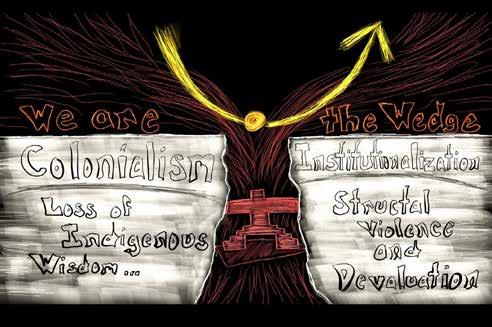

In its early manifestations the Beloved Community develops organically as passion for life generates multiple and varied expressions of just and creative relationships. These become possible because social surfaces that appear impenetrable are riddled with microscopically tiny cracks. When a tiny seed finds just what they need to germinate, root tips work, molecule by molecule, to follow and widen microscopic
paths of least resistance. Thickening roots widen cracks. Microbes digest stone. Water seeps in to erode and undermine inhospitable surfaces. With time enough, as numbers and types of plants increase, a more diverse and alive ecosystem emerges.
Facilitating change involves seeing and nurturing seeds: people who want more of life enough to risk breaking open to sense possible pathways and co-create ways to grow into them.
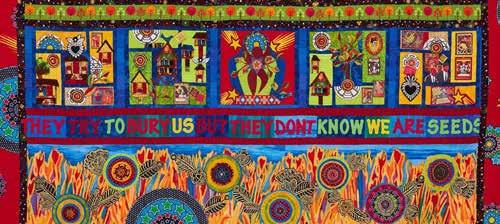
Beth Mount
Reverse perspective and imagine the change maker as a seed. The machinery of social exclusion is programmed to mindlessly bury us in a gray avalanche of fear provoking, life draining, compliance worshiping busyness. A good seed discerns and serves the pattern of life enfolded in its DNA. It makes a way out of no way by seeking space and nutrients to grow into its form and extending its roots to communicate and exchange with other growing organisms around it. It will play its part in evolving an ecosystem that promotes flourishing.
A way to keep on
There is a crack in everything That’s how the light gets in.

Leonard Cohen
The birds they sang
At the break of day
Start again
I heard them say
Don’t dwell on what Has passed away
Or what is yet to be
Yeah the wars they will
Be fought again
The holy dove
She will be caught again
Bought and sold
And bought again
The dove is never free
Ring the bells that still can ring
Forget your perfect offering
There is a crack in everything
That’s how the light gets in
We asked for signs
The signs were sent
The birth betrayed
The marriage spent
Yeah the widowhood
Of every government
Signs for all to see
I can’t run no more
With that lawless crowd
While the killers in high places
Say their prayers out loud
But they’ve summoned up
A thundercloud
And they’re going to hear from me
Ring the bells…
You can add up the parts
You won’t have the sum
You can strike up the march
There is no drum
Every heart, every heart to love will come
But like a refugee
Ring the bells…
The lyric that includes these lines piles up images to impress change makers with the limits of their efforts and nonetheless to praise a way of resistance. Wars will be fought again, the holy dove will be caught again, governmental sterility and impotence will thwart our efforts again and again. And yet change makers can confidently join in an anthem. Darkness is a tangible force and many calls to community have been silenced. But there are always cracks that allow light in and push back the darkness. There are always bells that can still ring. By attending to the present, stepping away from the crowd that downloads oppression, finding voice, and accepting the insecurity of refugee status, hearts will come to love. Perfect plans and errorless performance are beyond our reach, but thankfully imperfect offerings will let light contest with darkness.

In the eye of the hurricane the sky is blue and birds can fly there without suffering harm. The eye of the hurricane is in the very middle of destructive power, and that power is always near, surrounding that blue beauty and threatening to invade it…
In a world of moral hurricanes some people can and do carve out rather large ethical spaces. In a natural world and a social world swirling in cruelty and love, we can make room. We who are not pure ethical beings can push away the choking circle of brute force that is around and within us. We may not be able to push it far away, but when we have made as much room as we can, we may know a blue peace that the storm does not know.
–Philip Hallie
I am struck how different the metaphors of “cracks” are from “blue space”. Blue space is found within and among dynamic forces. The blue is a space within these turbulent forces and has a relationship with them. Blue space is facilitated and relational. It is also found within ourselves, as we create intention and internal conditions to connect with others in positive actions.
To me, cracks are found in rigid and calcified physical environments. They are external to us, they are both physical and social constructions. They appear when structures begin to deteriorate and lose their integrity. They also show as the life that emerges after destructive acts (Chernobyl) or natural disaster (Mt Saint Helens). The cracks and the life-forc-es are examples of resilience. To enlarge cracks often takes force, yet there are circumstances were something emerges in spite of unfriendly conditions.
This is a value of metaphor, it allows for different perspectives to enlighten our experience.
For more on blue space: Hanns Meissner. Creating Blue Space: Fostering Innovative Support Practices for People with Developmental Disabilities. inclusion. com
Thomas J. Neuville with C. Hannah Smith
Editor’s Note: This article describes the incorporation of the theory of SRV into a context perhaps unfamiliar to many of our readers; in this case, a university class for student teachers. This article and the practice of incorporating SRV with various human service approaches raise a number of questions which we hope to explore in future pages of this Journal. How does one balance SRV with other theories, approaches or practices? How well can SRV theory be used with other theories or practices? Does such incorporation create any tension(s)? How can these tensions be addressed constructively? What happens when SRV conflicts with another theory or common service practice? And so on.
I encourage university and college professors who incorporate aspects of SRV into their teaching to submit manuscripts to this journal describing these courses and their experiences teaching them. What successes and struggles have you and your students faced with the material? How well can students relate to social Role valorization if they have little or no prior experience with devaluation or devalued people? What have you and your students learned? What questions have been raised? Are there aspects of SRV which students seem to have a harder time understanding? If so, which ones, and what is the misunderstanding? Have you as a teacher had to pick and choose different aspects of SRV to focus on? What have you left out? And so on.
One cannot underestimate the importance of having student teachers come to be motivated to understand and be inspired by the theory and themes of Social Role Valorization (SRV). SRV, when used as a tool for bringing in particular heightened consciousness to the student teacher, has the potential to benefit that student, that student’s own future students, and countless others with whom each of these persons comes in contact. Perhaps no other student teachers benefit more from studying SRV than those pursuing coursework in special education. The potential benefits for the most vulnerable students, with whom the student teacher someday will surely have influence and impact, are untold.
I am fortunate to have the opportunity to teach a sophomore-level required course in my University’s teacher preparation program titled “Psychological Aspects of Individuals with Disabilities.” I say fortunate because I clearly benefit as much as, if not more than, my students as my instruction and the students’ engagement with the material allows for continual exploration and application. Pedagogi-cally, the course offers significant opportunity for lecture and participatory processing. Through this course, it is my intention to provide the student teachers with concrete tools and refined theoretical concepts unavailable elsewhere in their teacher preparation coursework and practicum.
As evidenced both by the anguish I hear expressed by colleagues who would prefer students not “bring that SRV stuff into my classroom” (after all, it complicates things), and by students, years past their graduation, reporting the importance of the course to their current teaching, the course clearly has both
instigatory and impactful consequences. While the course’s future is always uncertain (perhaps due, in part, to its powerful nature), for now it continues to be made available to students.
The nature of the course, as with SRV itself, often engages the student to journey from anger to embrace, from surface understanding to a deepening, and from viewing the material as a belief system to evidencebased applicable theory. Some, many, do not make these connections and are typically blocked by immature value systems. Those who do, however, engage in a profound journey that leads them, at the conclusion of the course, to be able to answer questions such as “How, specifically, does your ability to identify the socially constructed experiences of individuals with disabilities prepare you as an educator to facilitate an empowered and unified P-12 (prekindergarten through 12th grade) learning community?”, to which students reply “It is important to have knowledge of the person with the disability first before learning about their disability. It is important to know about their life, study habits, and interests when creating a unified learning environment,” and “These concepts are key when facilitating an empowered and unified learning community; I am helping students build the basic skills critical for academic success, to help them take charge of their own learning.”
The teacher candidate, according to the National Council for Accreditation of Teacher Education (NCATE) standards, must graduate with the ability to teach all students. “The methods of building capacity within individual students, parents and communities are critical to education reform and the serving of diverse students” (Vos, 2002). When I first was introduced to the course I now teach, several problematic issues exposed themselves. The course, originally written by a faculty group trained at a state institution, focused on terminologies, diagnostic characteristics, and behavioral screening tools. One might have expected this focus were it the 1960s or 70s. However, given the comprehensive and depthful information offered by Dr. Wolf Wolfensberger since that time, and to which I had been exposed, it would have been inexcusable for me not to subject the course to a comprehensive review process. After extensive revision to the course content, the course maintains a focus on psychological aspects while benefiting from current researched perspectives on the importance of social roles (Wolfensberger, 1998; Gottheil & Dubow, 2000; Hartung, 2002), disability as a social construct (Hartung, 2002; Goodley, 2001), and the need for acculturation and social integration as it applies to education (Minnes et al., 2002).
Psychological and sociological aspects of individuals with disabilities are surveyed. Environmental and socio-cultural factors are emphasized and analyzed in relation to human adjustment and social roles. Coherent educational service recommendations and whole person assessment concepts are explored. The history of services, socially constructed definitions, and characteristics of the disability movement form a basis for understanding.
! Identify the socially constructed experiences of individuals with disabilities and the resulting power structures.
! Identify the characteristics of individuals with disabilities resulting from sociological and cultural variables.
! Identify behavioral characteristics and causes brought on by the psychological and sociological assumptions about the roles of individuals with disabilities.
! Develop capacity to use personal awareness effectively as it applies to diversity, multicultural collaboration, and ethics.
! Analyze, evaluate and think critically regarding the socio-political impacts on support services and individuals with disabilities.
! Prepare the student for his or her life’s work.
The course objectives and assignments are based on Bloom’s taxonomy and as such use two of the critical areas: (1) Cognitive (Bloom, 1956): mental skills (Knowledge); and (2) Affective (Krathwohl, Bloom & Masia, 1973): growth in feelingsor emotional areas (Attitude).
The course links experience (ten hours of community service) with analysis of socio-cultural realities (use of SRV and Social Devaluation exercises).
The course discussions, readings, experiences and products call each student to engage in critical thinking by applying the themes of SRV, which have been internalized by experience, to scenarios of educational settings.
Students demonstrate, in future courses and teaching environments, a carryover of the applicability of the themes of SRV as they engage methods and implement lesson design.
The course assignments emphasize the incorporation and understanding of devaluation and wounding, as well as the themes of SRV. These assignments have evolved over time and are part of a comprehensive 30 page syllabus (a copy may be acquired by contacting the author). The assignments are founded on student analysis (see Sample Exercise 1), research regarding associated laws (see Sample Exercise 2), and teaching the material as it pertains to a specific given subject (see Sample Exercise 3). During the past two semesters, a requirement to analyze a human service environment (see Sample Exercise 1) was enhanced by adding an expectation of including the 10 Themes of SRV1 (Wolfensberger, 1998), including unconsciousness; the conservatism corollary; the dynamics of interpersonal identification; the power of mindsets and expectancies; the dynamics of role circularity; symbolism and imagery use; model coherency, and relevance and potency; personal competency enhancement and the developmental model; the power of imitation; and personal social integration and valued societal participation. The addition of the integration of the 10 themes of SRV has given clarity to the project and enhanced classroom discussions. Additionally, the themes continue to play a prevalent and relevant role in subsequent courses.
The most potent coursework includes exploration of the following exercises:
Sample Exercise 1–Social Devaluation Discovery Project (35% of total grade). This assignment is designed to assess the impact of social devaluation on an individual, understand human needs, and create ideal environments of support that positively cause a more desirable future. The student volunteers a minimum of 10 hours over a minimum of 3 visits at a human service provider of the student’s choice. The student assesses the environment and its impacts on the psychological and sociological experience of a person served by that provider. The student (1) demonstrates a comprehensive understanding of wounds, (2) has clearly considered the realities of a person’s life experiences, and has evaluated the degree and presence of wounding experiences (according to the framework of the 18 wounding experiences of vulnerable people,2 as proposed by Dr. Wolf Wolfensberger), (3) demonstrates a personal internalized comprehension, (4) demonstrates understanding of the responsibility of the service provider to respond to the individ-ual’s wounding experiences past and present, and (5) has competently and comprehensively
considered, explored, and portrayed the importance of relevance, potency and model coherency, clearly combining these components for an overall assessment. The analysis of an ideal human response must make practical use of a minimum of six of the ten major recurring themes from SRV. Of these six themes, these three must be included: interpersonal identification; the power of mindsets and expectancies; and personal social integration and valued social and societal participation.
why not tell someone else about it? We believe Social Role Valorization is an important tool that concerned individuals can use to address social devaluation in people’s lives. As someone who shares that belief, encourage others to read and subscribe to the only journal dedicated to SRV. Information available at http://www.srvip.org/journal_general.php.
Sample Exercise 2–Special Education Law Project (20% of total grade). This assignment may be completed individually or in groups. The student researches the history of Special Education Law. The student produces a paper that details the history of various educational and civil rights laws3 (including the ADA - Americans with Disabilities Act, NCLB - No Child Left Behind, Oberti and Gaskin cases, and IDEA - The Individuals with Disabilities Education Act), assessing the impact the laws have had on options for creating valued social roles for marginalized people. The student (1) makes a clear link between social devaluation as detailed by Wolfensberger and other texts, (2) lists the actual impact of the specific law on people with disabilities, and (3) uses sections of the law and its intent to demonstrate an understanding of the potential positive impacts. Initially, the law project tended to result in retellings of the laws and histories as one might easily construct after completing an internet search. After the expectation of linking the information to social devaluation was added, as well as a requirement to provide evidence of the positive impact on people with disabilities, students began to use the method of application of the themes not only in this assignment, but in subsequent assignments and their own classroom content design work as well.
Sample Exercise 3–Group student Teaching Project (30% of total grade: 15% oral; 15% written). Student teams (three to four students) prepare an oral and written presentation related to a subject provided by the instructor. These subjects are related to current topics in the education of students with disabilities (i.e., self-advocacy and self-determina-tion, full inclusion as social justice ideology, historical perspectives on charity-pity relationships, impacts of standardized testing, belonging and valued social roles, inner work, disability culture, voices of the marginalized, right to die and death-making, issues with the concept of ‘tolerance,’ and uses and abuses of person-centered approaches). Each team designs a 30-minute comprehensive in-class learning experience and provides supporting evidence for their findings.
The required texts are a Mix of evidenced-based theory (Wolfensberger, 1998), practice (May & Raske, 2005), SRV Journal materials, and historic cultural trends (Schwartz, 1997). The texts all build on one another, allowing the student to coherently draw upon the resources available therein.
! May, G. & Raske, M., eds. (2005). Ending disability discrimination: strategies for social workers. Boston, MA: Pearson, Al-lyn, & Bacon.
Loss of natural/freely-given relationships and substitution of artificial/paid ones
Deindividualization
Involuntary material poverty
Paid relationships based on stewardship: the paid person is accountable for outcomes in the individual’s life, without acting to define that person’s life purpose, control the actions of the person’s environment, or caretaking of the individual (where caretaking carries the assumption of fundamental incompetence)
Celebrations of who the individual is with understanding of the importance of oneself (of one’s soul) and of the world
Control of financial resources both earned and entitled Impoverishment of experience, especially that of the typical, valued world
Exclusion from knowledge of/participation in higher-order value systems
Having one’s life wasted
Brutalization, death-making
Awareness of being a source of anguish to those who love one
Awareness of being an alien in the valued world; personal insecurity, perhaps dislike of oneself
Immersion in experiences, opportunities and learning which are generally highly valued
Inclusion in (knowledge of and participation in) higher-order value systems that give meaning to life and provide community
Having a flourishing life which is marked by growth, prosperity, success, and thriving–on multiple levels in multiple realms
Being the receiver of all that is humane; being imaged as alluring or captivating, so much so that people have thoughts of renewal, regeneration and ‘lifemaking’
Being a core of solace and inspiration, a ‘heart-ener’ to people who love one
Appreciation of one’s role and contribution in the world
As mentioned earlier in this article, clearly not every student is able to internalize the material. Overall, however, I do believe even a willingness to grasp for understanding of the material is valuable. Additionally, while there are clearly some students who glimpse the implication of the power of the material, the systems they are entering have years of practice and multiple strategies to convince them that what they see or are caused to ponder is simply an ideal, but not based in realistic possibility. Because of this, as part of the coursework, I ask each student to construct an ideal school environment founded specifically on the 10 themes of SRV. This sharpens the student’s focus and benefits their design. While students often continue to believe in the perfectibility of structures and systems, especially special education models, they clearly have a new level of consciousness about the forces at work. Given these limitations, the course content is continuously under review and revised, as deemed appropriate, in an effort to ever more fully provide the students with tools and resources of value to their journey. For example, the current ‘Call for Papers’ issued by The SRV Journal (see page 4) will be followed with an effort to collect papers addressing each of the 10 themes of SRV. These papers will become a bound resource for classroom assignments, the intention of which is to provide further potential for deepening understanding on the part of the student of the concepts presented and explored.
There have been a few Surprises throughout this journey. Surprisingly, colleagues report that students have pulled out the Wolfensberger text and their research paper and presented them as evidence counter to what the professor teaches. Even more surprising, the professor occasionally reports that the student has persuaded him or her. The other significant surprise is the amount of work the students are willing to engage in and submit. They are willing and eager to meet the high expectations placed upon them. They produce two research papers (one of 25 pages and one of 40 pages), one group subject paper (10 pages), and design and deliver a lesson relevant to course material. Colleagues report this level of expectation to be masters’ level work and yet the students predominantly report highly positive
experiences such as the student who expressed, “This course provided a very applicable understanding of special education. I appreciated that we not only learned about special education within the school system, but we also learned about the foundational problems of discrimination and devalorization. The class, along with the group work and community service, got me more interested in the personal aspects of special education, rather than just the disorders, laws, or systems. Having knowledge of socially constructed experiences will be a great advantage to me not only when working with people with disabilities, but in simply being a member of society.”
While the course content will continue to be reviewed and modified as needed, I am confident the changes that have been implemented, specifically the integration of SRV theory and themes, will make all the difference in the impact our future teachers have in the lives of students, particularly those most vulnerable.
1. Further exploration of these themes may be achieved through attendance at an introductory or advanced Social Role Valorization workshop. Information on these workshops is available at www.socialrolevalorization.com.
2. Please see Figure 1, the reciprocity table on robustness, included in this article. The left-most column of the table reflects the 18 wounds as proposed by Dr. Wolf Wolfensberger. Further exploration of these wounds may be achieved through attendance at an introductory or advanced Social Role Valorization workshop, as well as reading Wolfensberger, 1998. Information on these workshops and other SRV resources is available at www.socialrolevalorization.com.
3. US educational civil rights laws relevant to students with disabilities, including: ADA – The Americans with Disabilities Act was enacted in 1990 and is a wide-ranging civil rights law that prohibits discrimination based on disability. Disability is defined as “a physical or mental impairment that substantially limits a major life activity.”
NCLB – The No Child Left Behind Act, enacted in 2001, aimed at improving the performance of schools in the United States and is based on the theory of standards-based education (the theory that high expectations and measurable goals will improve outcomes for students).
IDEA – The Individuals with Disabilities Education Act was enacted in 2004 and governs how states and public agencies provide early intervention, special education, and related services to children with disabilities.
Bloom, B.S. (1956). Taxonomy of educational objectives. Handbook I: The cognitive domain. New York: David Mc-Kay Co., Inc. Goodley, D. (2001). Learning disabilities, the social model of disability and impairment: Challenging epistemologies. Disability and society, 16 (2), 207-231.
Gottheil, N. & Dubow, E.F. (2000). The interrelationships of behavioral indices of bully and victim behavior. Paper presented at the 108th Annual Conference of the APA, August 4-8, in Washington, DC, US.
Hartung, P. (2002). Cultural context in career theory and practice: Role salience and values. Career Development Quarterly, 51(1), 12-25.
Krathwohl, D.R., Bloom, B.S., & Masia, B.B. (1973). Taxonomy of educational objectives, the classification of educational goals. Handbook II: Affective domain. New York: David McKay Co., Inc.
Minnes, P., Buell, K., Feldman, M., McColl, M., & Mc-Creary, B. (2002). Community integration as acculturation: Preliminary validation of the AIMS interview. Journal of Applied Research in Intellectual Disabilities, 15(4), 377-387.
Vos, R. (2002). Collaborating to close the achievement gap. Paper presented at the Annual Meeting of the American Association of Colleges for Teacher Education, February 23-26, in New York, NY, US.
Wolfensberger, W. (1998). A brief introduction to social Role valorization: A high-order concept for addressing the plight of societally devalued people, and for structuring human services (3rd ed.). Syracuse, NY: Syracuse University Training Institute for Human Service Planning, Leadership & Change Agentry.
THOMAS NEUVILLE, PHD, is an Associate Professor of Education at Millersville University in Pennsylvania, Us. He has more than twenty-five years experience in community and organizational development. C. HANNAH SMITH is a community member whose life is enriched by personal relationships with vulnerable people. She credits social Role valorization as a powerful framework which influences how she parents her children.
The citation for this article is
Neuville, T. with Smith, C. (2008). SRV & teacher prep: Not just a course, but a course of action. The SRV Journal, 3(2), 18-25.
by John McKnight
I met a remarkable woman in a little town in Southern Georgia. She worked for a service agency responsible for mentally retarded people in a three-county area. Her agency decided it was too focused on deficiencies and needed to think about the gifts, contributions, and capacities of the people who were its charges.
So this woman began spending time with the people the agency had once called “clients” to see if she could understand -in their homes-what gifts they had to offer. She went to the home of a forty-two-yearold man who had been the victim of special education -segregated education. His name is Joe. He has one short leg (at least he limps), and he doesn’t speak the way a lot of people speak. (I’m not sure what label deficiency-finding psychologists would give him. But I’m sure they would give him one.)
At age twenty-one, Joe had no place in society. So he went home to a pig farm. Every day he did two things. He fed the pigs twice a day, and he sat in the living room where he listened to the radio. (He couldn’t see to watch television.)
The woman told me that after four days at Joe’s house she couldn’t find his gift. “But on the fifth day,” she said, “I realized what his gift was: he listens to the radio.”
“I found out that three people in town spend all their time listening to the radio, and they get paid for it. One is in the sheriff’s office, one in the police department, and one in the local civil-defense office. So I looked at each of these places where a person sits, listening to a radio all day. I liked the civil-defense office best. It’s a voluntary organization. They have a house that somebody gave them; so the voluntary ambulance people sleep in its bedrooms. There’s a desk and sitting right by the desk is a radio getting all the calls from the county. At the desk sits a twenty-seven-year-old woman who listens for calls and dispatches volunteers when someone needs an ambulance.”
So she told the dispatcher, “I have somebody here who likes to listen to the radio as much as you do. I’d like to introduce you to him.” And so she introduced Joe to her, and they put a chair on the other side of the desk, and he sat there every day listening to the radio.
This little house is also the neighborhood community center. Somebody is always there. People come and talk and drink coffee in the dining room. Sometimes they show movies.
Whenever anybody was there, Joe would go in. Everybody came to know Joe, and he became a part of that neighborhood. When Christmas came, the volunteers gave Joe a radio of his own to listen to at home in the evening because Joe had been with them and had shared his gifts in the face of their hospitality.
Joe began to go downtown at noon to eat at the diner. One day he went into the diner and the owner of the diner said, “Hey, Joe, what’s happening?” Joe looked at him and said, “The Smith house over in
Boonesville burned down this morning. And out on Route 90, at that turnoff where you can have picnic, there was a drug bust. And Mr. Schiller over in Athens had a heart attack.” Everybody in the diner stopped talking and looked around at Joe. They couldn’t believe it. They realized that Joe knew the answer to the question “What’s happening?” because he listened to the radio all morning.
When I went to visit this town and the woman who introduced Joe’s gift of listening to the radio to the community, I saw an incredible thing. I saw, first of all that the dispatcher and Joe were in love with each other. Then when I went with Joe to lunch, I saw that everybody who came into the diner came over to Joe first and asked, “Joe, what’s happening?” And I realized that I was in the only town of the United States that now has the gift of a town crier.
The woman told me she was planning to take Joe over to the newspaper editor. It had occurred to her that in this little town with a little newspaper and one editor, the editor couldn’t possibly know “what’s happening.” But by noon Joe knew. And if Joe would go over and talk to the editor every noon, the grasp, the breadth, the knowledge, of the newspaper and what it could report would expand mightily.
So Joe is now a stringer for the local Gazette. He showers his gifts on the community because somebody knew that community is about capacities, contributions, and hospitalities -not about deficiencies, needs, and services.
by Ann O’Connor
…Please forgive me if I don’t use the proper word in vogue these days for us folks who are consigned to the categories of physically handicapped or developmentally disabled, or mentally impaired. It would wear a person out trying to keep up to date on the current acceptable language. In any case, there’s a lot of talk these days – and from handicapped people as well – that people like us do not want to be considered as different, or at least that our differences should be ignored because (it is being said) we are no different than anyone else. Perhaps this is one way of insisting that our human dignity and value be acknowledged and accepted. Or perhaps this is an expression of how our culture levels everything out to a certain flatness or sameness. But nevertheless, the reality of our situation is, and there is no denying it, that we are different. We are different than those not so afflicted, which is most people. We are, by our affliction, set apart. Yes, we are different in superficial ways such as physical appearances, mental capabilities, in the way we talk, or don’t talk. But we are also different in the way we perceive the world and reality and our place in it. Our very presence reminds people of their own vulnerability and mortality, and that their idols of youth and beauty and physical fitness are passing away.
So because of our difference and the hard truth which our presence speaks – and which people don’t want to hear- others avoid us, and society wants to keep us out of sight. We’re told we’re not productive and. Therefore, not valuable. We are made poor, and then told we are a financial liability to society. Our differences then become, to others, our whole identity. We are called “victims“ of some disease or other, or patients instead of persons, or we become a “case” and a number in someone’s case lead. The process of depersonalization deepens as we are regarded as less than human, and others look past us or through us, as if we are not there.
However, as all of us here know, once people are willing to give us their attention and look into our eyes, they can get to know who we are and they no longer experience our difference as a problem or barrier or a threat. What wounded people require is, as William Stringfellow says, that we be called by name and taken seriously.
I believe that we must not hate being different, not deny it. I believe that difference is our vocation. Our difference is a gift to us, to those around us, and to society. By vocation, I mean, that each of us is called to be the unique person God intends us to be, and thus to accomplish something that only we, as that unique person, can do. By vocation, I do not mean jobs or careers, or accomplishments such as financial success or fame or glory. I am speaking on the deeper, more important level of living the truth and serving others with that truth. Those of us who are afflicted can discover a great truth. The more deeply wounded we are, the easier it is to see: It is the truth of the great dignity of human beings and the eternal destiny to which we are all called. Our vocation is to live the truth that this is not all there is in life- what can be seen, or touched, or heard – that under the surface is where the treasure is buried, a pearl of great price. Our vocation is to be a sign to the world of sacredness of each human life, from the moment of conception until natural death.
We serve others best, I believe, by calling them to the truth about themselves and about human life and God. Simply by being, we (who are afflicted) call others to the truth. This is the great gift of wounded people – the truth the world hungers for, the gift that others need if they are not to lose their souls.
So instead of denying our difference, or hating it, we have come to see our difference as a vocation and a gift we have been given to share…For most of us, we discover our gifts and vocation only through those around us who love us and serve upon us. Share your gifts of heart and soul, so that simply by being and struggling against all odds, you will serve life.
Ann O’Connor is a hospitaller at Unity Kitchen, in Syracuse, NY. She was invited to act as emcee at Team B’s Awards Luncheon on June 28, 1989. These excerpts of her opening remarks are from “Person to Person”, the newsletter of an Onandaga County, NY citizen advocacy group.
The following piece is a clear depiction of the difference our society sees between people with disabilities and those without.
by Elaine Popovich
I am a resident. You reside. I am admitted. You move in.
I am aggressive. You are assertive.
I have behavior problems. You are rude.
I am non-compliant. You don’t like being told what to do
When I ask you out for’ dinner, it is an outing. When you ask someone out, it is a date.
I made mistakes during my check writing program; someday I might get a bank account.
You forgot to record some withdrawals from your account and the bank called to remind you.
I wanted to talk to the nice looking stranger I saw at the grocery store, I was told it is inappropriate to talk to strangers. You met your spouse in the produce department when neither of you could find the bean sprouts.
I celebrated my birthday yesterday with five other residents and two staff members. I hope my family sends a card. Your family threw you a surprise party. Your brother couldn’t make from out of state. It sounded wonderful.
My case manager sends a report every month to my guardian. It says everything I did wrong, and some things I did right. You are still mad at your sister for calling your mom after you got that speeding ticket.
I am on a special diet because I am five pounds over my ideal body weight. Your doctor gave up telling you.
I am learning household skills. You hate housework.
I am learning leisure skills.
Your t-shirt says you are a “couch potato”.
After I do my budget program tonight I might get to go to McDonalds if I have enough money. You were glad that new French restaurant took your charge card...
My case manager, psychologist, R.N., occupational and physical therapists, nutritionist, and house staff set goals for me for the next year. You haven’t decided what you want out of life.
Someday I will be discharged ....maybe. You will move onward and upward.
Throughout history, people with physical and mental disabilities have been abandoned at birth, banished from society, used as court jesters, drowned and burned during The Inquisition, gassed in Nazi Germany, and still continue to be segregated, institutionalized, tortured in the name of behaviour management, abused, raped, euthanized, and murdered.
Now, for the first time, people with disabilities are taking their rightful place as fully contributing citizens.
The danger is that we will respond with remediation and benevolence rather than equity and respect. And so, we offer you
by Norman Kunc and Emma Van der Klift
Do Not see my disability as the problem. Recognize that my disability is an attribute.
Do Not see my disability as a deficit. It is you who see me as deviant and helpless.
Do Not try to fix me because I am not broken. Support me. I can make my contribution to the community in my own way.
Do Not see me as your client. I am your fellow citizen. See me as your neighbour. Remember, none of us can be self-sufficient.
Do Not try to modify my behaviour. Be still & listen. What you define as inappropriate may be my attempt to communicate with you in the only way I can.
Do Not try to change me, you have no right. Help me learn what I want to know.
Do Not hide your uncertainty behind “professional” distance. Be a person who listens and does not take my struggle away from me by trying to make it all better.
Do Not use theorems and strategies on me. Be with me. And when we struggle with each other, let that give rise to self-reflection.
Do Not try to control me. I have a right to my power as a person. What you call non-compliance or manipulation may actually be the only way I can exert some control over my life.
Do Not teach me to be obedient, submissive, and polite. I need to feel entitled to say “no” if I am to protect myself.
Do Not be charitable towards me. The last thing the world needs is another Jerry Lewis. Be my ally against those who exploit me for their own gratification.
Do Not try to be my friend. I deserve more than that. Get to know me. We may become friends.
Do Not help me, even if it does make you feel good. Ask me if I need your help. Let me show you how you can best assist me.
Do not admire me. A desire to live a full life does not warrant adoration. Respect me, for respect presumes equity.
Do Not tell, correct, and lead. Listen, Support and Follow.
Do Not work on me. Work with me.
Dedicated to the memory of Tracy Latimer
Written and Produced by Norman Kunc and Emma Van der Klift
Copyright 1995
Copies of the videotape/DVD available through Axis Consultation and Training (250)754-9939
518 James Street Suite B3 Syracuse, NY 13204
315/473-2978
Revised Feb. 2007 (excerpt)
PASSING is an instrument for evaluating the quality of any human service according to how well it implements Social Role Valorization theory. Social Role Valorization, or SRV, posits that people who fill positively valued social roles will be likely to obtain and receive the “good things in life”, while people who fill negatively valued social roles will find it much harder – sometimes impossible – to get the good things in life; in fact, they may be given only bad and harmful things. SRV further posits that the two major avenues towards positively valued social roles are image enhancement and competency enhancement; the more positive one’s image. And the more competent one is, the more one will have access to valued social roles, and therefore the good things of life. Obviously, SRV is of special relevance and applicability to people who currently hole devalued roles, or are at risk of being cast into such – in other words, to people who are devalued by their society.
SRV draws on a wide and historically deep body of empiricism, in spelling out what contributes to being cast into devalued roles, or being able to obtain and hold valued social roles. However, SRV does not and cannot say whether any of this knowledge should be used in order to contribute to the role-valorization of any party. In other words, SRV deals only with what the realities of human perception, learning, social valuation, and behavior are; questions of whether anyone, or a particular party, should be valued or devalued, or should hold positively or negatively valued social roles, in what contexts, which specific roles, etc. – all these questions go beyond SRV because they are issues above the level of empiricism.
PASSING is based on SRV, but PASSING gives only a brief explanation of SRV. Much more detailed and lengthy elaboration of SRV can be found in teaching events on it. Also, some aspects of SRV not covered in PASSING are found in a small book entitled A Brief Introduction to Social Role Valorization: A High Order Concept for Addressing the Plight of Societally Devalued People, and for Structuring Human Services. (Wolfensberger, 1998)
PASSING first began to be developed in the summer of 1979, was first published in 1983, and the new revised edition with the new name was published in 2007. PASSING was once an acronym that stood for
“Program Analysis of Service Systems’ Implementation of Normalization Goals.” However, Normalization was superseded by SRV, so in this new edition, PASSING is a name, not an acronym.
PASSING is partially derived from the PASS (Wolfensberger and Glenn, 1973, 1975) method of service evaluation; PASS stands for Program Analysis of Service Systems. PASSING replaces all of those parts of PASS that deal with programmatic rather than administrative issues. The residual uses of PASS are described in a separate flyer that may be requested by the training institute.
PASSING was designed to try to meet the need for an evaluation method which would be able to do the following:
Assess the quality of human services in relation to their adherence to Social Role Valorization (SRV) after Normalization and been re-conceptualized as SRV. SRV posits as the most important goal of services the establishment of valued social roles for people who are societally devalued or at value-risk.
SERVICE-STRUCTURED GROUPINGS & RELATIONSHIPS AMONG PEOPLE: 7 RATINGS
SERVICE-STRUCTURED ACTIVITIES & OTHER USE OF TIME: 3 RATINGS
OTHER SERVICE LANGUAGE, SYMBOLS & IMAGES: 6 RATINGS
SERVICE-STRUCTURED GROUPINGS & RELATIONSHIPS AMONG PEOPLE: 6 RATINGS
SERVICE-STRUCTURED ACTIVITIES & OTHER USES OF TIME: 3 RATINGS
NO RATINGS - NOT APPLICABLE
Each of the 42 ratings in PASSING is categorized as to whether it primarily affects recipients image or personal competencies; these are the two major goals of SRV. Ratings are further subdivided within these two major categories into one of four service domains: physical setting of service; service structured groupings and relationships; activities and other uses of time within a service; and miscellaneous. This makes eight potential categories into which a PASSING rating might fall. Thus, a rating that has to do with how an aspect of the physical setting affects recipients’ image would be located in the top left cell of the above chart.
Each rating in PASSING consists of five sections:
1. A narrative explanation of the rating issue, called “General Statement of the Issue.”
2. A “Rating Requirements and Examples” chart, which has four columns: one contains a brief statement of the rating issue and focus; one gives one or more examples of the rating principle as actualized in normative society; a third gives one or more examples of the rating as actualized in hypothetical human service situations; and the last provides one or more examples of human service violations of the rating principles.
3. A “Differentiation from Other Ratings” section, which explains how the rating at hand differs from other ratings with which it is likely to be confused.
4. A chart entitled “Suggested Guidelines for Collecting and Using Evidence” which lists typical sources of evidence for the rating, some key questions that must be answered in order to make a judgment on the rating, and some important and often overlooked considerations in regard to the rating.
5. Criteria for a continuum of five “levels” of service performance (explained below), called “Criteria and Examples for Rating Level Assignment.”
Each rating in PASSING has five levels, i.e. statements about a continuum of service quality and service performance in the particular issue assessed by the rating. Each level represents the same degree of service quality across all ratings. That is, Level 1 stands for the same level of quality on all 42 ratings; Level 2 stands for the same level of quality on all ratings; etc.
The rating levels are structured to form a balanced continuum, where the lowest level (Level 1, atrocious performance) represents the opposite of the highest level (Level 5, the “attainable ideal”), the intermediate levels (Levels 2 and 4) represent opposites of each other, and the middle level (Level 3) – the fulcrum of the balance – represents a service performance that is the balance of both strengths and shortcomings, so that the good and the harm done cancel each other out. The percentages of weight given to a particular rating are distributed the same way (within rounding error) across the five levels of each rating. Thus each Level 1 = -100% of the weight assigned to a rating, each Level 2 = -70%, each Level 3 = 0%, each Level 4 = +70%, and each Level 5 = +100% of the weight assigned to a rating.
Level statements of positive performance in PASSING are phrased in terms of the likely impact that service practices will have in recipients’ image or competencies, because it cannot always be known with certainty that a particular outcome in terms of denigration or enhancement of recipients’ image or competencies was caused by any one particular service feature.
For further information about PASSING or PASSING training materials or workshops, please contact the Training Coordinator at the Training Institute.
Wolfensberger, W. (1972). The principle of normalization in human services. Toronto: National Institute on Mental Retardation. Wolfensberger, W. (1980). The definition of normalization: Update, problems, disagreements, and misunderstandings. In R. J. Flynn, & K. E. Nitsch (Eds.), Normalization, social integration, and community services (pp. 71-115).
Wolfensberger, W. (1983a). Guidelines for evaluators during a PASS, PASSING or similar assessment of human service quality. Toronto, Canada: National Institute on Mental Retardation.
Wolfensberger, W. (1983b). Social Role Valorization: A proposed new term for the principle of normalization. Mental Retardation, 21(6), 234-239.
Wolfensberger, W. (1984). A reconceptualization of normalization as social role valorization. (Canadian) Mental Retardation, 34(2), 22-26.
Wolfensberger, W. (1985). Social Role Valorization: A new insight, and a new term for normalization. Australian Association for the Mentally Retarded Journal 9(1), 4-11.
Wolfensberger, W. (1998). A brief introduction to Social Role Valorization as a high order concept for structuring human services. (3rd edition) Syracuse, NY: Training Institute for Human Service Planning, Leadership and Change Agentry (Syracuse University).
Wolfensberger, W., & Glenn, L. (1975, reprinted 1978). Program Analysis of Service Systems (PASS); A method for the quantitative evaluation of human services (3rd ed.) Handbook and Field Manual. Toronto: National Institute for Mental Retardation. (earlier editions published in 1969 and 1973).
Wolfensberger, W., & Thomas, S. (1980). PASSING (Program Analysis of Service Systems’ Implementation of Normalization Goals. Wolfensberger, W., & Thomas, S. (2007). PASSING. A tool for analyzing service quality according to Social Role Valorization criteria. Ratings Manual (3rd rev. ed.) Syracuse, NY: Training Institute for Human Service Planning, Leadership, & Change Agentry (Syracuse University).
International Social Role Valorization Association
Founded in 2014, the SRVIA is a voluntary organization which works to connect and support SRV practitioners around the world. We manage the SRV website at www.socialrolevalorization.com. Visit our website for information on SRV-related groups, contact, events, and up-to-date information on the International SRV conference.
International Social Role Valorization Association
Our purpose is
“To promote SRV development, education, assessment, and leadership to assist people and organizations to implement SRV concepts so that vulnerable people may have access to the good things of life.”
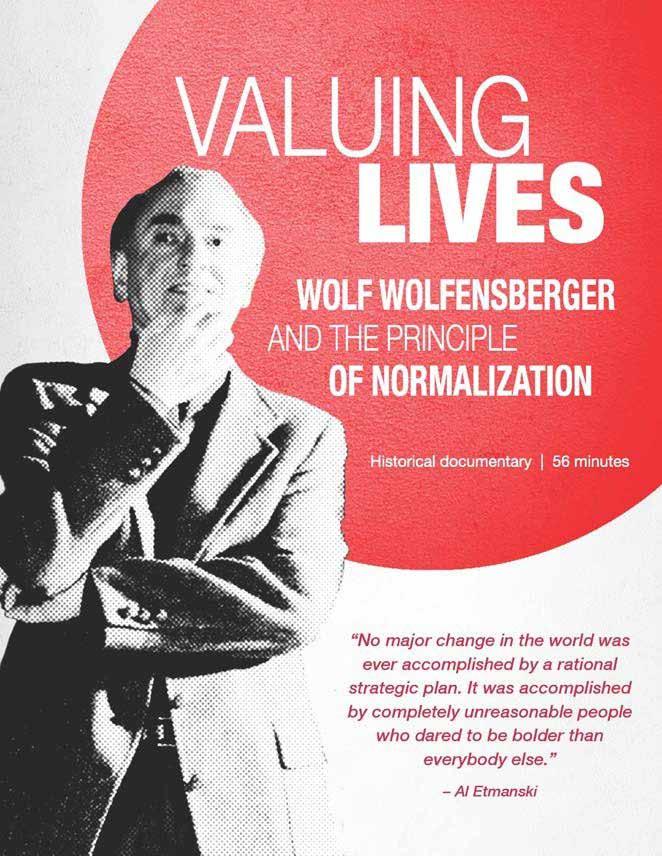
Just released in 2015, the film is currently premiering across North America and Europe. For more information on viewing and ordering this documentary film, visit http://rtc.umn.edu/valuinglives/
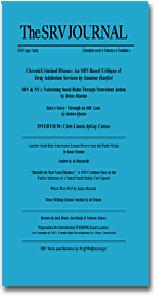
We believe that Social Role Valorization (SRV), when well applied, has the potential to help societally devalued people to gain greater access to the good things of life, and to be spared at least some of the negative effects of social devaluation.
Toward this end, the purposes of this journal include:
1. disseminating information about SRV;
2. informing readers of the relevance of SRV in addressing the devaluation of people in society generally and in human services particularly;
3. fostering, extending and deepening dialogue about, and understanding of, SRV; and
5. encouraging the application of SRV, as well as SRV-related research.
We see this journal as a helpful addition to the international SRV training culture.
We hope that the information provided in this journal will help those in relationship with devalued people, as well as those specifically involved in service to others (both formally and informally; and at all levels, including by family, friends, advocates, direct care workers, managers, trainers, etc.) to advocate for, and to provide, more valued life conditions and more relevant and coherent service. We believe that
interested persons and ‘servers’ can do this primarily by helping devalued people to attain and maintain valued social roles. We believe that over the long run, such efforts will improve the life situations overall of vulnerable people, increasing their access to the ‘good things of life.’ We sincerely hope that this journal will contribute to such efforts.
The journal will be published twice a year. Print copies of back issues will also be available on a limited basis for purchase. Subscription prices will be kept as affordable as possible.
In addition to print subscriptions, more affordable PDF subscriptions are also available. PDF issues will be emailed at the time of publication. Also, you can subscribe to both the PDF and print issues for specially priced subscription rates, as shown below.
Marc Tumeinski (Editor) The SRV Journal 74 Elm Street Worcester, MA 01609 USA 508 752 3670 journal@srvip.org
For on-line ordering, please visit: http://www.srvip.org/journal_pay_online_choose.php
www.socialrolevalorization.com
This website is the go-to for SRV resources, international trainers, training events and group worldwide, and all sorts of SRV information. It is maintained by the SRV International Association (SRVIA), and membership information is available on the website.
https://keystoneinstituteindia.wordpress.com/
The Blog of the Keystone Institute India is focused on writing and reflection which is influenced by an SRV perspective.
http://rtc.umn.edu/valuinglives/
This website contains information about the new documentary film “Valuing Lives: Wolf Wolfensberger and the Principle of Normalization” along with extensive extended interviews. http://blog.srvip.org/
A scholarly blog by the SRVIP, a Massachusetts-based SRV organization committed to SRV teaching, learning, and use. http://www.mncdd.org/wolfensberger/index.html
This website contains rare video capture of Dr. Wolfensberger’s History of Human Services and Reflections Workshops.
“Injustice any where is a threat to justice every where.”
- Martin Luther King Jr
1
Think of examples of wounding towards devalued people you have seen in your life – How do you think these wounding experiences affect people?
2
Which wounds do you think impact people with disabilities most deeply in your society and within your work?
3
What most impacted you about today’s presentation?
Personal Unconsciousness
Think of examples where you have lost consciousness about important realities in regards to devalued people. What are you at risk of losing consciousness about?
Think of examples of unconsciousness within a human services organization you are involved with. What has the impact been? What is the risk of this unconsciousness if it continues?
Unconsciousness in Human Services
Unconsciousness within Indian Society
Can you think of any societal practices that clearly end up oppressing and devaluing people? What are they and how do they oppress people?
If everyone in this person’s life was aware of the wounding process and really knew what the person’s life has been like and what the person faces on a daily basis, how could that awareness change things for the person? How can your awareness change things for the person?
Unconsciousness as it Relates to your Focus Person
! Think of your own life – how do you compensate for your vulnerabilities. For example, if you are not equally competent in all areas of your job, how do you compensate?
! Think of a few people you love and feel very close to. Think of some of their vulnerabilities. What is your instinct in the face of their vulnerabilities? How do you help them with their vulnerabilities?
! Reflect on the things that make the person vulnerable and ask yourself, “What is this person vulnerable to?”
! How could the conservatism corollary be applied in the person’s life to “prevent, reduce, and compensate”?
! How would the application of the conservatism corollary potentially change the person’s life?
Please read the article and identify some of the mindsets and resulting expectancies:
How are these mindsets likely to impact on the student?
Please take some time to reflect on the written vision and mission of the agency you work in or work with – what it is and what are the mindsets and expectancies behind the mission and vision?
Please identify and reflect on 2 negative service practices in the agencies they work in. What are the mindsets and expectancies behind those practices? Can you list them?
Please reflect on the impact of mindsets and expectancies about the focus person you have been thinking about.
Find an example of imagery from everyday life or human services which is juxtaposed with devalued people. Good places to search are newspapers, the internet (google disability, schizophrenia, autism, etc), magazines, billboards, or human service settings.
The image you choose could convey positive or negative images about devalued people.
Consider the following questions:
1. What message is conveyed by the image about devalued people?
2. Which of the “channels” does this image use to convey a message about people?
y Personal Presentation
y Physical Setting
y Social Environment (the people surrounding the person)
y Activities
y Language
y Miscellaneous (logos, symbols, funding)
If possible, bring a picture or copy of the image with you to the workshop tomorrow, and be prepared to share it as well as your answers with other workshop participants. If you cannot bring the image itself or a picture of it, please be prepared to describe it.
Within the life of one person
Within the Family and Close Social Network
Within the Community
Within Human Services
Within Society
“Without reflection, we go blindly on our way, creating more unintended consequences, and failing to achieve anything useful.”
- Meg Wheatley
Keystone Institute India
B-6/22, First Floor, Safdarjung Enclave
New Delhi – 110029
Tel: 011 49053451/52 | www.keystoneinstituteindia.org